“The distance from the sentence to your eye is my sculpture.”
- ‘Distance’ Ken Friedman - 1971.
Folk art found me (Doc), Alex Busby, 1993:
I first watched this film maybe 5 years ago, and have since watched it countless times - I recommend it to everyone I speak with and find it especially illuminating in moments of creative block.
The artists interviewed in this short documentary all work in rural Canada and do not have any formal training in the arts. Coming from a mixture of working backgrounds, from hunters to car mechanics, the interviewed artists speak on their practices and how life has filtered into their work.
Conversations had are of the use of auto-body filler in sculpture building, of a woodsman’s photographic memory, of a tactile working with hand tools, and art as an antidote to nervous temperaments and possible traumas.
Works produced are direct expressions of lived life, passed through a few conceptual filters. Many of the artists express something to the extent of - when an artwork comes together, it has a life of its own. It is not something you can trick into existence, and it is not something you have control over to a certain degree.
Following the Naugler brothers, we see the artists judge their work by how others receive it - and there is no pretence outside of this. The true depth of the work is in the knowledge of the artist’s hands, and the use of ‘non-art’ materials in the production of experimental sculptures - that is to say, materials whose weight & history come from places extraneous to the Western art world.
In the case of the Naugler brothers, materials are carried over into new artistic dimensions, from the world of Nova Scotion auto-body repair, in a gesture identical to Fischli and Weiss’ The Way Things Go, 1987. (See U2 CRITICAL CONTEXT).
As Jeremy Millar would suggest, referencing Mikhail Bakhtin’s essay ‘Epic and Novel’, there is a certain comedy in this action/ and of this action, within which “[The object] is [delivered] into the fearless hands of an investigative experiment.” (cited in Millar, 2007, p.57)
That is not to say that the works of the Naugler brothers are inherently funny, but rather emulate in their function Arthur Koestler’s triptych for patterns of creative activity (’The act of Creation 1964); describing a cycle of creative liberation of “comic comparison - objective analogy - poetic image” (cited in Millar, 2007, p.38) - Through which the 'every day' is liberated and granted expansion into new possible dimensions outside of the routine and established.
Millar, J. (2007) Fischli and Weiss - The Way Things Go. London: Afterall.




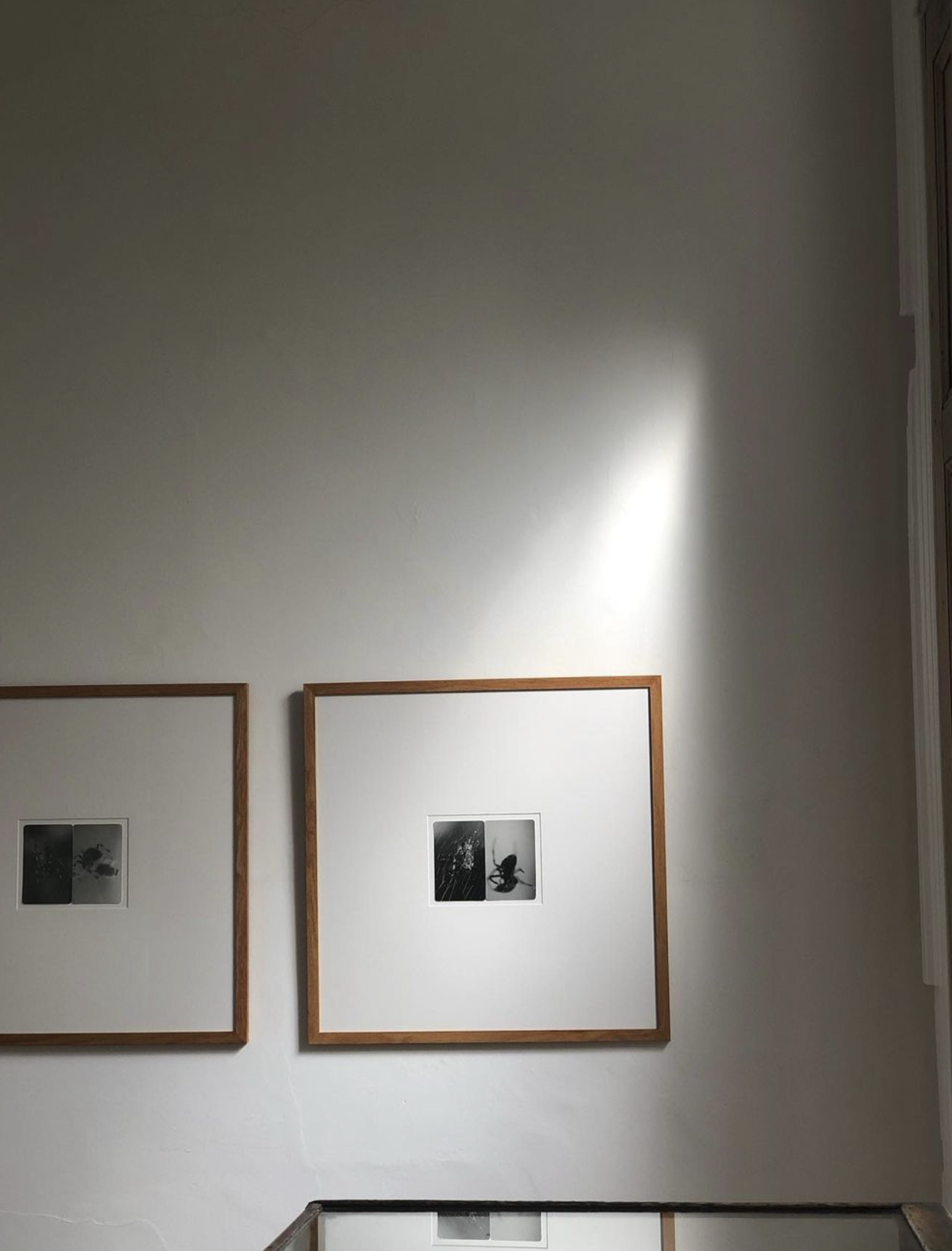
Spider Portfolio @ Serchia Gallery, Bristol (26/01/23-26/02/23):
It is my 2nd exhibit of this work, and it's exciting to see it reimagined in a new space. The museum in which it was originally shown curated the show around the idea of analogue photography in present times, and the outcome was maybe a bit gimmicky, the prints provided examples of a technique and they were hung on light-brown walls - I wasn’t overly happy with the final aesthetic of the show. At Serchia the works have their own room, hung in a beautiful domestic space with white walls and wooden floors which I hope may entice collectors/ provoke their imagination (Serchia is starting to work with an art advisor so I have produced a price list and I am hoping to sell from this series). The work is sensitive and focused on a confined space so I am much happier seeing it shown in a quiet, and naturally lit site.
The photographic documentation that Serchia produces differs from my desires, this seems to be more common than not, and so I am considering getting down to making digital documents of the show - more in line with how documents were produced for my U1 Ophelia show in studio C131.
What Serchia is great at is promoting young artists' work and connecting people. There will be a closing party on the 24th, where I will read out a manifesto connected to this work.
A statement provided for the show:
There is an idea about humankind, that we are the caterpillar growing unknowingly towards our rebirth as a butterfly. That we are subconsciously pushing ourselves around a great circle, feeding some other intelligence - or adding to some millennia-old collective memory that will one day be the life source of our replacement.
It is an idea present in science fiction novels - imagining a world taken over by self-learning A.I, a process seen in nature as dandelion flowers turn to seeds, and it is a way that we make art - lost in translation, carefully nurturing the essence of the materials we work with while we dilute their wholeness in place of what they will become a part of.
Spider Portfolio (bridge/intro/acknowledgement) From Clayton’s SLC19 catalogue (2018) deals with these discourses; translation, sustenance, gestation, and regeneration.
Existing as a single edition of 18 Silver-Gelatin prints in 9 pairs, Spider Portfolio was produced in its entirety in the garden shed Darkroom of Clayton's previous home in Brighton, UK. Quickly adopted by local garden spiders as their new home, the Darkroom became a place of claustrophobic focus. Clayton became enchanted by the Spiders’ dance, body structure and performances of entrapment, making documents during the day and performing Darkroom work after nightfall. Prints were then washed in his bath and left to dry all over the apartment on top of hardcover books, a process through which conversations started to form and pairings naturally occurred.
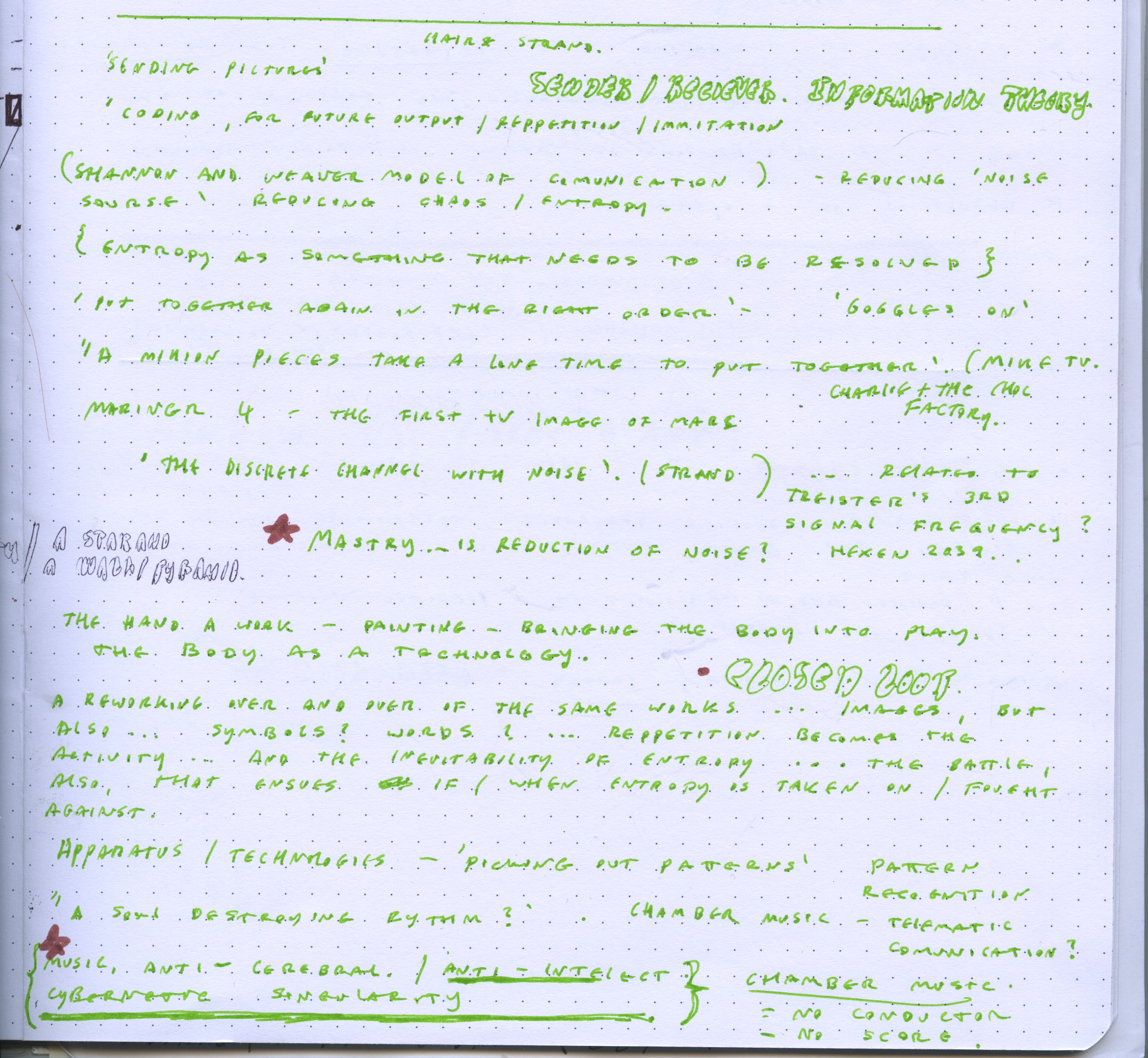
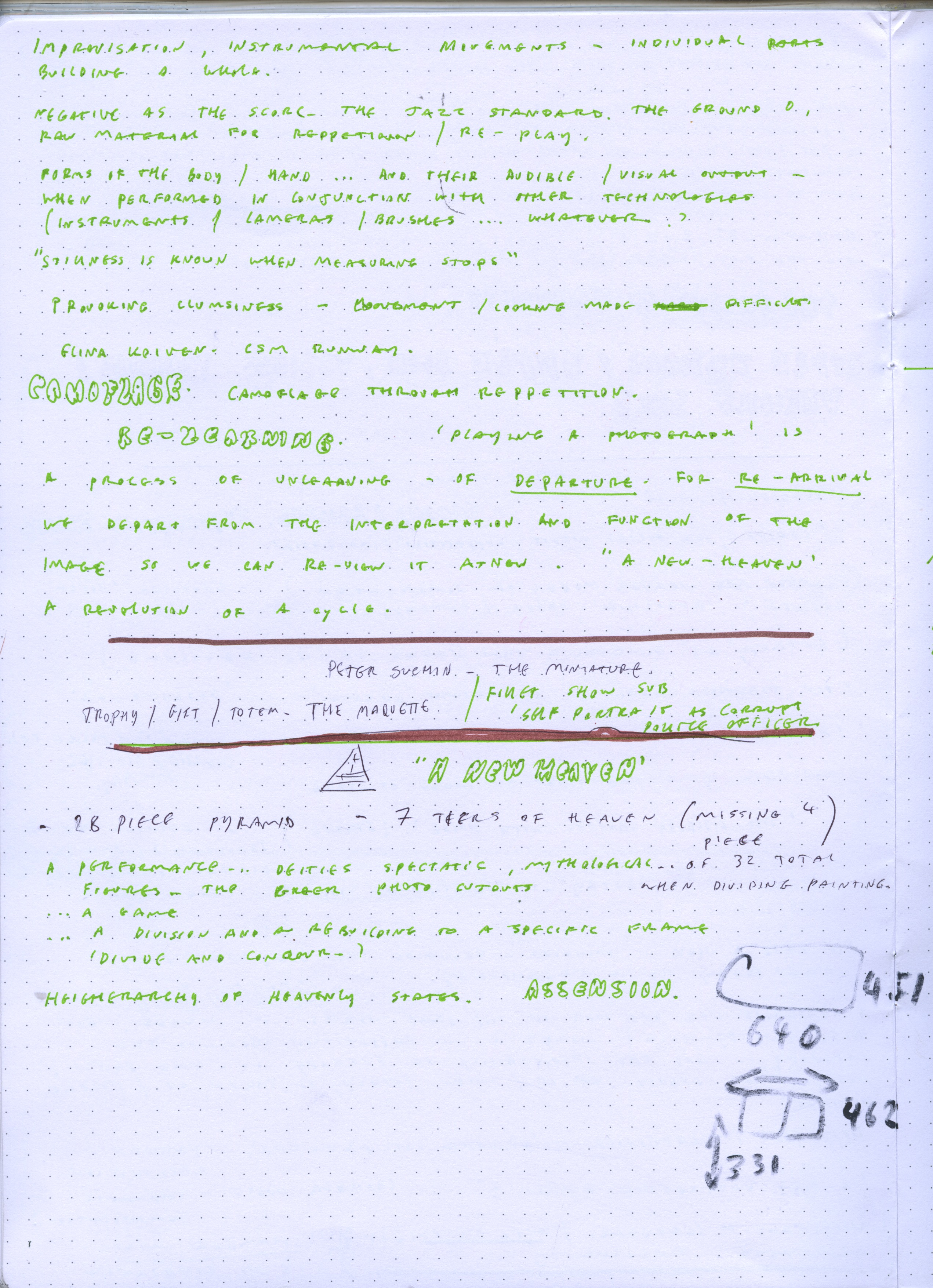
Clare Strand seminars:
Camouflage, relearning, departure/ re-arrival, chamber music (no score), closed-loop, information theory.
P.K.D Metz speach 1977:
(Transcription excerpts):
(Speaking on multiple planes of reality) “although originally I presumed the differences between these worlds were caused entirely by the subjectivity of the various human viewpoints, it did not take me long to open the question as to whether it might not be more than that. That in fact plural realities did exist - superimposed onto one another like so many film transparencies. What I still do. not grasp, however, is how one reality out of the many becomes actualised in counter distinction to the others.
Perhaps none does, or perhaps again it hangs on an agreement in viewpoint by a sufficiency of people. More likely the matrix world, the one with the true core of being, is determined by the programmer. He/ or It articulates, prints out - so to speak - the matrix choice and fuses it with actual substance... the core or essence of reality, that which receives or retains it, and to what degree. This is within the purview of the programmer.
This selection and re-selection is part of general creativity. A world-building.
It seems to be its or his task. A problem perhaps - which he or it is running - which is to say in the process of solving... as a computer will.”
Dick’s explanation of the artist? / is the self, is the programmer? An entity in analysis of its own existence. Perpetually creating and dismantling his/ its own world. The individual and the collective.
Dick continues:
“The metaphor of a chess board is especially useful in evaluating how this can be done. In fact, must be. Across from the programmer/ re-programmer sits a counter entity whom Joseph Campbell calls the dark counter-player. God/ the programmer/ re-programmer is not making his moves of improvement against inner matter...he is dealing with a cunning opponent. Let us say that on the game board, our universe is space/ time. The dark counter-player makes a move... He sets up a reality situation of immutable cause and effect... But the programmer/ re-programmer has already laid down his response. It has already happened - the moves on his part. The printout, which we undergo as historic events, passes through stages of a dialectical interaction - thesis and antithesis as the forces of the two players mingle.
Evidently, synthesis fall to the dark counterplayer - and yet they do not - by virtue of the fact that in advanced, great advocate selected variables... the alternation of which brings final victory to him. In winning each sequence in turn- he claims some of us, we who participate in the sequence.“
“I doubt if we will ever be able in any real way to demonstrate, to scientifically prove that such lateral will change processes do occur. Probably all we would have to go on would be vestiges of memory. Fleeting impressions, dreams, nebulous intuitions that somehow things have been different in some way- and not long ago, but now.”
Dick poses self/ programmer/ God as one entity... enacting lateral change processes... shifts between realities, made like moves on a chess board. As each player selects and re-selects moves it is seen that they are both hand- and game pieces by extension. guided by an unconscious will, it takes effort for the piece to contemplate the hand, and the consciousness in turn guides the hand.
In blindness, it is easy for a piece to forget that it is an extension and one with an entity extra-dimensional to the game board. This is an explanation of metaphysics.
“A reflex left over from a previous presence, still active at a subcortical level. We might dream of people and places we have never seen, as visibly as if we had seen them and actually known them. But we would not know what to make of this... assuming we took time to ponder it at all. [...] The acute, absolute sensation that we had done once before what we were just about to do now. That we, so to speak, lived in a particular moment or situation previously. But in one sense could it be called previously- since only the present, not the past was evidently involved. We would have the overwhelming impression that we were re-living the present - Deja Vu.
Perhaps in precisely the same way - hearing the same words, saying the same words - I submit that these impressions are valid and significant - and I will even say this; such an impression is a clue - that at some past time point, a variable was changed - re-programmed, as it where, and that because of this an alternative world branched off - became actualised instead of the prior one... and that in fact, in literal fact, we are once more living this particular segment of linear time.”
What Dick is explaining, of worlds branching off, and the shuffling of linear time, is reminiscent of Hugh Everett’s Many-worlds interpretation (MWI) of Quantum Mechanics. It is in this context that I like to think of artworks within my own assemblage practice as a visualisation of quantum alterations - of thought and of the object (inner/ outer, of the heavens/ of the ground) - in an ever-expanding/ multiplying reality...produced through an intuitive working.
I thus read recent works (such as ‘Arcanum XXI’) as visualising rips in the fabric of space and time - housing beings from multiple dimensions (the Star, the Greek icon, the Holywood celebrity, the video game avatar)... one energy in 5 alternate dimensions...to quote Dick; “in fact, plural realities [do] exist - superimposed onto one another like so many film transparencies.“
It is the maintenance of an intuitive working, a certain balance, that forms a bridge, I feel, between the programmer/ re-programmer and the human vessel.
As if operating from a fully intuitive position would be a direct channelling of God, and with each increment of sword-like (Tarot) learned behaviour/ knowledge, we step further from the true essence of information, our works becoming diluted in stages. (There is a link here to the two polarised forces of ‘Wonder’ and ‘Curiosity’ discussed in [Millar, J. (2007) Fischli and Weiss - The Way Things Go. London: Afterall.]
“[…] A breaking, a tinkering, a change… had been made, but not in our present. Had been made in our past. Evidently, such an alteration would have a particular effect on those persons involved. They would, so to speak, be moved back one square or several squares on the board game which constitutes our reality. Conceivably, this could happen any number of times, affecting any number of people, as alternative variables were re-programmed. We would have to live out each re-programming along the subsequent linear time axis… but to the programmer, who we call god, to him the results of the programming would be apparent once. We are within time and he is not… we are living in a computer-programmed reality, and the only clue we have to it is when some variable is changed, and some alteration in our reality occurs.
This clue might account for the sensation people get of having lived past lives. They may well have, but not in the past. Previous lives, rather, in the present – in perhaps an unending and repeated present, like a great clock dial in which grand clock hands sweep out the same circumference forever… with all this carried along unknowingly, yet dimly suspecting”
Division of labour, FRONT (75x75x5.5cm) Acrylic, photo-cut-outs & map pins on chipboard, set into fire-door W/ crayon, 2023
Entopy of a painting, studio documents, 2023
The work now titled ‘Division of labour’ has served as a nice, kind of exaggerated example of my creative process...In its very production, it exists as a cover-up:
Finding a couple of chipboard panels, I started some acrylic paintings which I quickly became frustrated with. These became painted over, and over, and nailed into, and nailed back into me... and cut hands... and so they were taken downstairs to the woodshop and cut up on the panel saw.
These blocks almost became a sculpture... but 2 pannels made it out, became repainted again and finally set into a big chunk of ex-fire-door.
My old friend, the CNC, saved the day again... and has become a new solution for finishing many works! I spoke with an artist friend of mine recently, Tom Heatley, on a studio visit, about this kind of thing. What sticks and what falls away. Processes, once available, once an opportunity... can, by happenstance, become a go-to in one’s practice. Certainly... cutting out pockets on the CNC was a checkpoint moment in mine. What is also made possible is flush hangings! using a combination of CNC routing and laser-cut fittings! (see pics)
To go into the work itself... everything is a spectrum. The expanding field of information is a spectrum. We have the rainbow, a spectrum of light and a symbol of the heavens/ divine message/ House of Cups (and also linked to MK Ultra, an infamous 1960s CIA psychedelic drug experiment program focused on mind control). It is cast over a diptych citing Bach, and MK Ultra (there is a history of audible triggers being used on sleeper agents in mind control experiments in mid-century USA)and we have the presence of the Greek sculptures who make an appearance in all recent works as distant, omnipresent, overseeing deities (New world order figures). On the reverse there is a comedic manifestation - envisioning a future in which the work is hung at MoMA PS1.
Telephones are symbols of communication. Here we are confronted with a novelty telephone... perhaps making a specific comment on the transmission of data in art and painting... there is an abandonment of seriousness in communication or a mocking of its impossibility, or a fear of its dilution. This forms a contemporary analysis of the divine message (House of Cups), reflecting the search for divine inspiration, and the subsequent encounters with infinitely competing frequencies of information.
We have enough elements here for a conspiracy. Something is being communicated or rather seeded... a childish innocence is met with sinister undertones of control and manipulation. We consider the insidious nature of that which is sold to us through bright colours, and fun characters. We consider the methods through which data is fed to us, presented, camouflaged, as various trojan horses - we presume a hidden message in Bach’s Brandenburg concerto.
Presented as a diptych (a theme I am experimenting with in many works/ the diptych as well as the double-sided work), reference is made to the icon, and iconography - for example in catholic religious painting. The messages that are being sent to us... we can no longer tell where they are being sent from. The field of information has become saturated, and one can no longer trust If inspiration has come in the form of divine communication or in the form of soft-drinks advertisement. The thoughts we have are certainly not our own, and the ones with the most money can whisper the loudest.
Simply, art imitates life - an environment of confusion and conspiracy produces work of confusion and conspiracy. One could think of the old idea of the Artist’s message as long since dead, and accepted in its death (design and illustration adopted by the world of knowing). In this way I see my work to act as a mirror held to the present day - My art is of the world of questioning, of observing the field of saturated information. One gets the feeling that there is a message in there somewhere! but we can't quite seem to find it, and I do not presume to know fully myself, what I can do Is to produce, to reflect... and speculate on such elements that come through, the same as any viewer - as I am trying to do now.
The elements that I can recognise in my work are shared in Science Fiction literature (as well as TV/ Film narrative). Pointing to this as a reference in recent work, I feel there is something crucial to observe when the faults of a system become so widely known that they become normalised tropes, and seep into that culture’s fictions. In Science Fiction over the past 6/7 decades, it seems something happens where... corruption, fear, nihilism, separation, conflict, corporate monopoly, and environmental ruin, have become immortalised, and remain untouchable like anti-heroes.
One does not even have to thoughtfully observe to witness the rate that which information is being fed to us on an everyday and increasingly accelerating basis.
The corporate gods and their advertisements have at large replaced old-world faith and spirituality, to the extent that even ancient spiritual practices (yoga) and traditions (Christmas) have been commoditised.
Artists evolve with the times.
Considering the amount of information being transmitted to the average human mind 100 years ago compared to now, the notion of being an ‘artist’ (which I like to think of as a creative processer and out-putter of contemporary information) in 2023 is a completely different thing... we are connected to many more dimensions.
To even try to gather inspiration outside of the world of the corporate gods, of the mass media internet age, one likely has to sever a limb... to cut out the android heart by doing something so radical as leaving their phone at home, and even this becomes a rebellious gimmick. One can find a remote residency and travel to the ‘other’ which is that world that existed before, but it is play-acting. To live in society now... to be an artist in society and to ignore the influence of the corporate world and its dominion over our thought is to ignore a large portion of where our information comes from.
In this respect, I think it is important and inevitable for contemporary work to contain traces if not whole chunks of conspiracy, mind control, confusion, omnipresent forces of power, oppression and rebellion within selected systems. Through owning such phenomena the artist can bring them forward, placing these in reach of critique. That is essentially the action of art... to provide statues of manifest thought for purposes of re-analysis.
What is lost in big shows? The difference between reflecting the confusion of the saturated field of information, and, contributing to it:
Recently I have helped out in the unpacking of artworks for ‘Forces Of The Small’ @ Fillet Gallery 03-07/03/23, as well as acting as a member of the curation team for the University-wide exhibition at Bargehouse this coming April.
Although I became interested in the idea of the miniature in ‘Forces Of The Small’, in terms of it relating to ideas of playing cards/ many parts of a whole... pieces to be played... helping Sarah and Peter Suchin at Filet reminded me of the nature of big shows. Although there did become an interesting play between micro and macro in this show, with 130+ small works joining almost to create one new organism, I found it difficult to connect with such a vastness of work contained in a single show. My experience in this situation is to de-tune, in quite the same way I would if I were watching a news station for a prolonged amount of time.
For this reason, I couldn't help but feel that a show of this scale, although an interesting concept, was contributing to - rather than critiquing the saturated field of information.
Perhaps I was too close to the show in terms of its set-up, but I was left with the feeling that there was nothing particular to be deciphered. Because of the nature of the open call and the number of artists involved, I found it difficult to take it as a serious curation, rather a showcase of small works.
Similarly, Spending time on/ with the Bargehouse Curation team (working with around 100 exhibiting artists), I quickly realised it was more of an exercise in Tetris. With this many students showing work the show again becomes a showcase rather than a curation. Artists are promised space regardless of the content of their work - which is of course how university shows work, but this vastly changes what we term curation for these events.
As curators, we were asked to arrange works into separate rooms - looking at thumbnail images of the work, but due to the vastness of proposals and the pre-guarantee of a place in the show - our main curatorial power was to separate audio and projection works, suggest if a work was perhaps too large, and distinguish between brick walls/ white walls/ light & dark spaces.
The functioning of such shows, I understand, is to ensure all students show work, to meet time and organisational constraints, and to allow students to experience aspects of exhibition organisation... as artists, curators, documenters, designers etc...
However at this stage in my practice, the student showcase/ large show becomes less and less exciting, and for my particular work, I feel a more considered and intimate space is required to further the reading and invite the type of patience my work requires.
These recent experiences have helped affirm the kinds of shows that I am personally interested in being involved in! the kinds of shows that I feel can both challenge and take forward my work; Shows in the vein of Hannah Barry's recent show: ‘Spring without End’ featuring the work of Stevie Dix, Danny Fox, and Norman Hyams.
Considering works as entities unto themselves, players, characters...I see the process of exhibiting as a real opportunity for selection and refinement. Choosing the games in which the works can be observed to play is hugely important and I think for me it is a crucial part of how my practice can evolve and I can learn about my work. I have to see my works play the kinds of games they were made for, It is important to see how they behave in the contexts that I imagine them to be considered in.

Stevie Dix ‘I dreamt you gave me more’, 2023. Hannah Barry Gallery.
(https://hannahbarry.com/artist/stevie-dix/#gallery-grid-6379)
Spring without end - Stevie Dix, Danny Fox, Norman Hyams. Hannah Barry Gallery Feb-Apr 2023 (Stevie Dix speaks in an interview with Riccardo Pillon):
“[...] true to themselves: they share an honesty and emotional realism that speaks to an authentic sense of self - fraught, shifting, hard-won.”
- Hannah Barry press release
“[...] I wanted to work in a shape that felt it had a chronology, and shows multiple sides, without it really having to make sense.” ...
This is felt in ‘I dreamt you gave me more’, through the assemblage of multiple canvases. I got the sense of accumulating dimensions... of the body, of the earth, of thought. I jumped straight to the Tarot and Catholic Triptych.
Pillon describes them as ‘Fragmented geometries’ which makes me think of Rene Dumal’s Mount Analogue: A Novel of Symbolically Authentic Non-Euclidean Adventures in Mountain Climbing (1959). Between these links one could come to consider assemblage as a manifestation of Non-Euclidean space... a reflection/ visual communication of many worlds theory, or the existence of multiple overlapping dimensions. We may choose to describe these many worlds as whole worlds in themselves, aspects of subjective human experience, or fragments of a collective consciousness compartmentalised and stuck back together. These become phrases which act as Russian dolls, representing the nature of all things as simultaneously divided and multiplied. There is both a separating and a bringing together visible in ‘I dreamt you gave me more’ which in itself is an act of both micro and macro reflection - the nature of humans and the nature of the world, through us, and outside of us... “multiple sides, without it having to make sense.”
Note: Non-Euclidean space is a factor prevalent in the Tarot and in nearly all religious theology. Systems are described as, and function as, collections of considered divisions - limbs of a whole broken, or ‘digitised’ with overlaps made possible by the fact they are divided. Dimensions are created rather than discovered, divisions of heaven and earth, of the 4 houses of the Tarot, of spirits and humans, of receptivity and activity. It seems to be human nature to both create these dimensions and then attempt to merge them, somehow, conceptually. It's an activity of Art, like a ceaseless re-testing, discovering which divisions stick and which fall away as we continually morph.
“[...] I wanted the work to have a protagonist and ideally, one that felt somewhat neutral. Knowing the work will always have different audiences, I found the best way to achieve neutrality was to stay close to myself”
I think this says a lot about the work. We, the viewer, start to divide the artist’s experience, their internal & external spaces, pondering them like a map or a riddle... or something between the two... comparing them to our own. As she alludes to the Infinite nature of the subjective audience, I read Dix’s use of the word ‘Neutrality’ in the Eastern sense... attached to the idea of Zen, and Nothingness as the basis for reality.
It makes me think of the phrase, I think Allen Ginsberg used to use... something like “To be universal, you have to be specific”.
I always took this as relating to some sort of collective consciousness, and ideas in Zen Buddhist meditation; that we are all one energy, and at the core of the individual is the collective and visa versa.
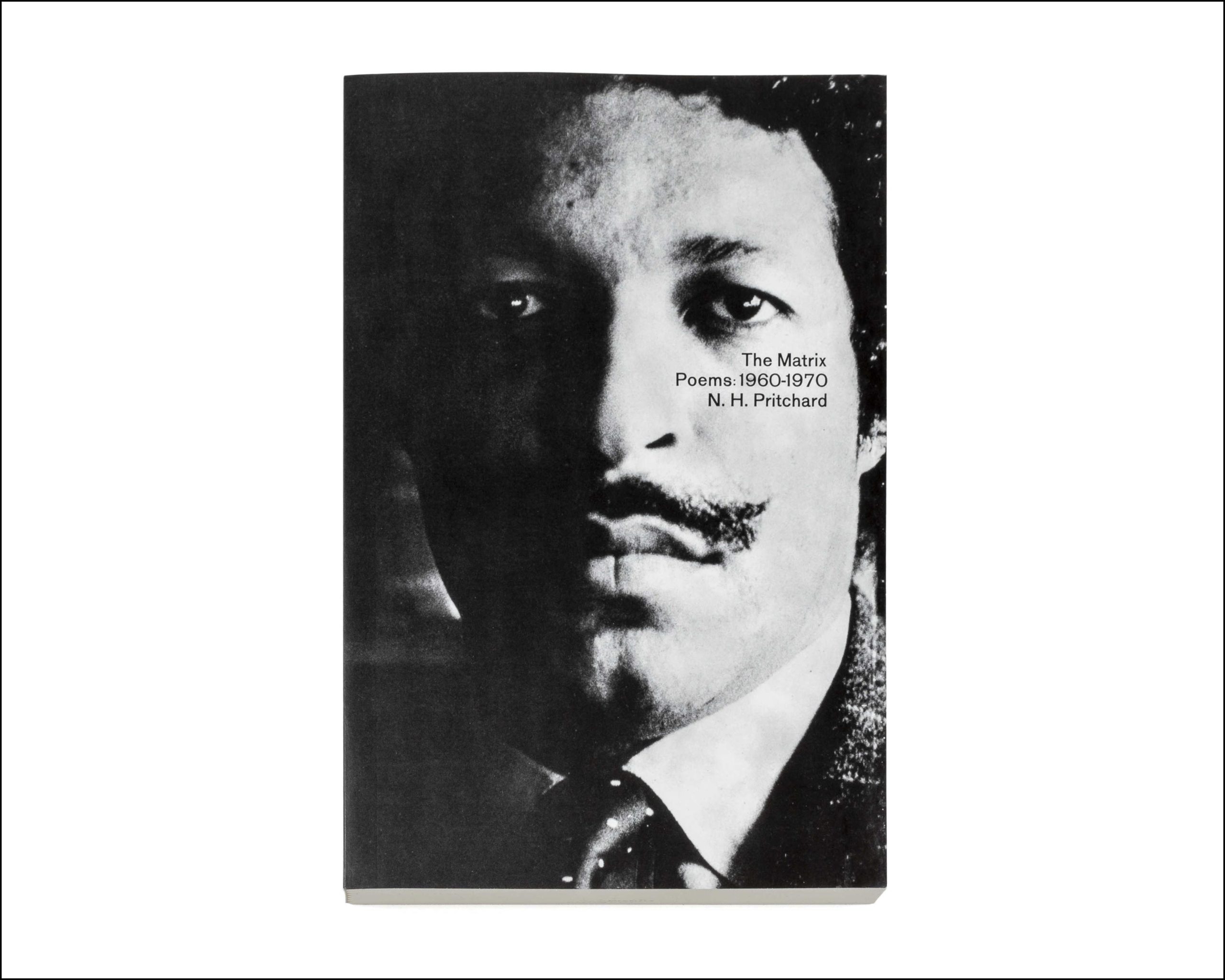

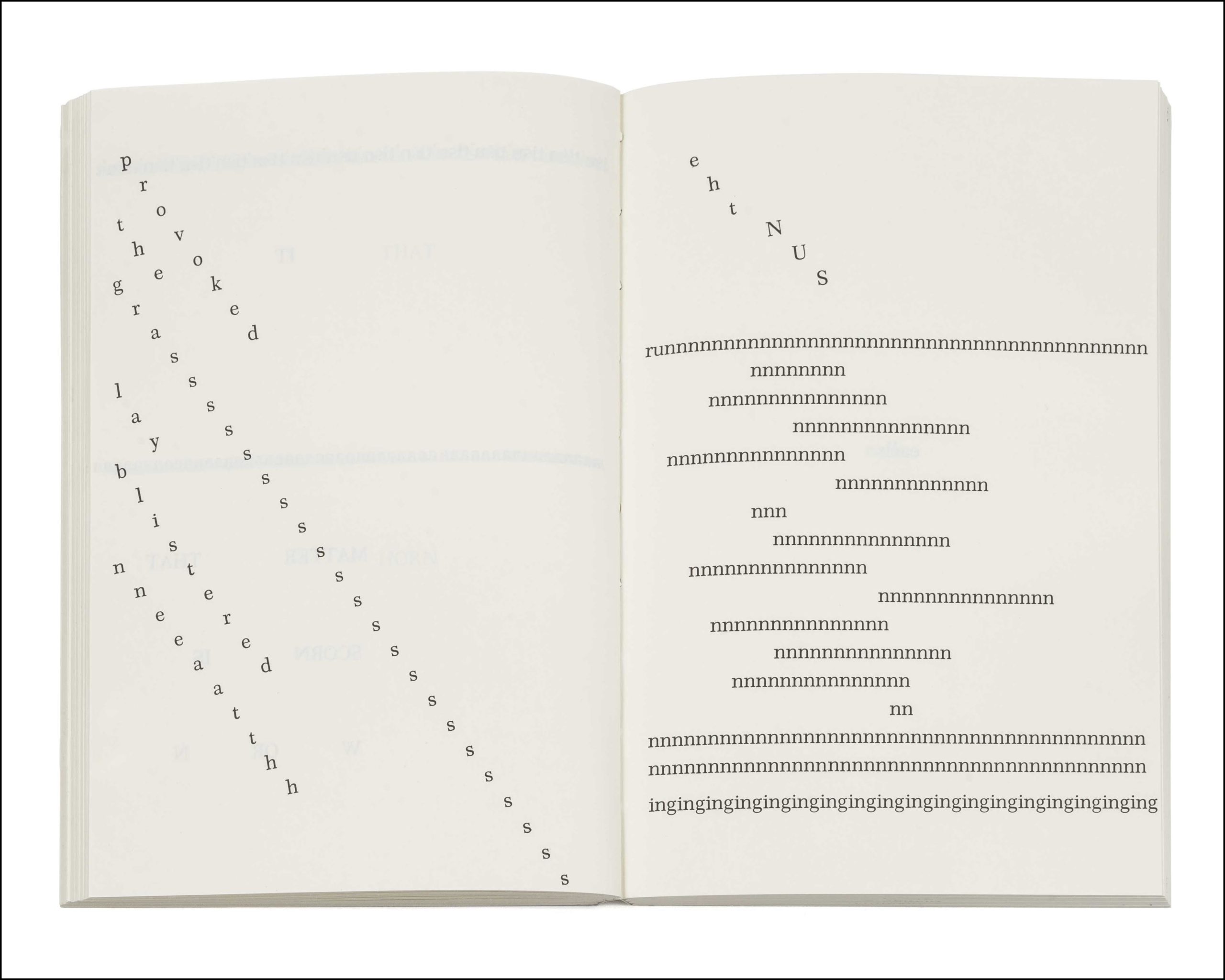
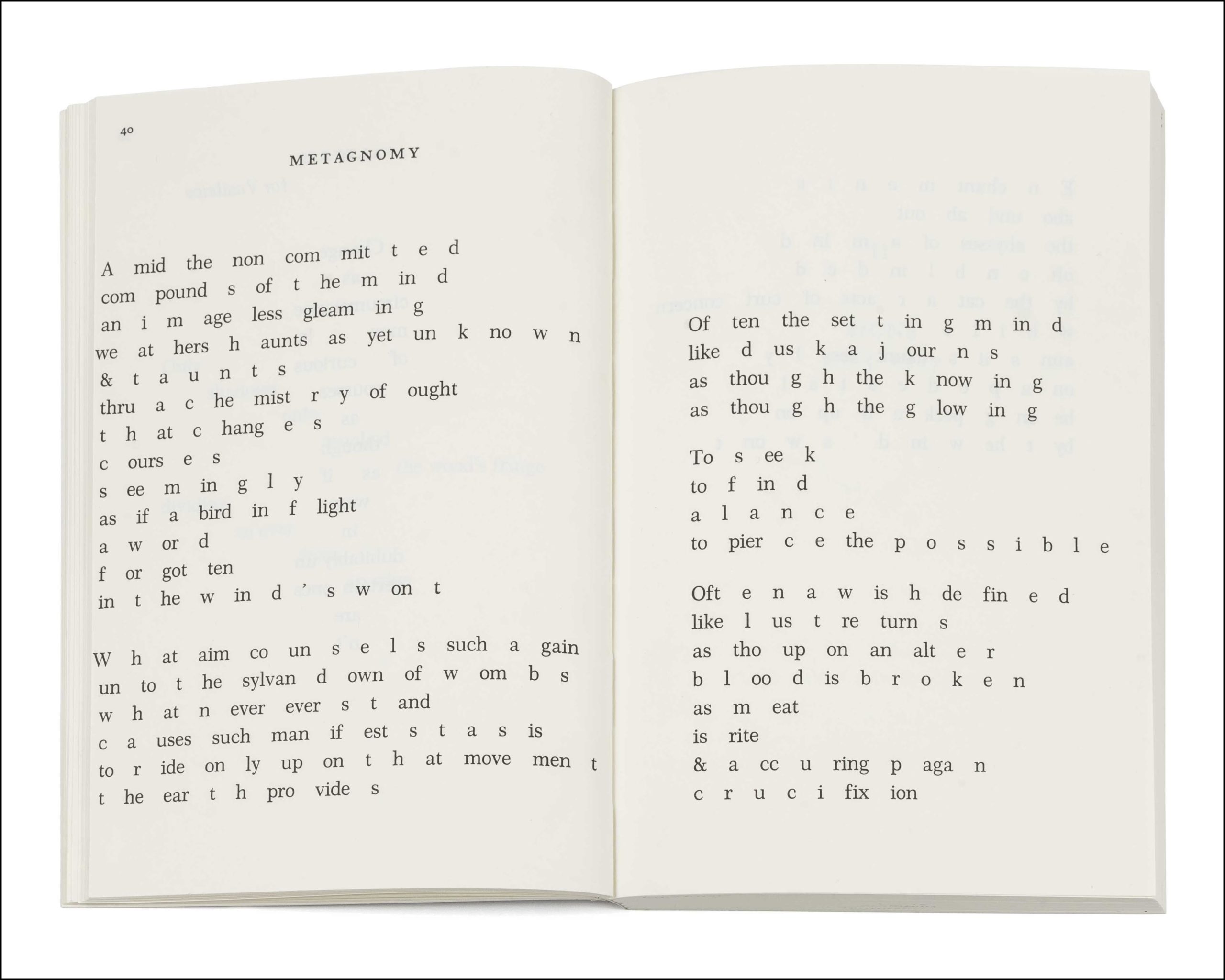
Photos- https://primaryinformation.org/product/the-matrix/
The Matrix poems 1960-1970 - N.H. Pritchard:
Pritchard deconstructs language through fragmentation and disjuncture. He often employs unconventional syntax, breaking sentences and phrases into fragmented units. We must actively participate in deciphering and reconstructing the meaning within the text if we are to pull anything from it, highlighting the limitations of language and the inherent subjectivity of interpretation.
In Pritchard’s Matrix poems, the spatial arrangement of words on the page is a visual deconstruction in itself. Words become objects/ material... they undergo what Baudrillard would describe as “functional transcendence” (1) which is to say they rebell automation and the subsequent “sacrificing of [...] potential functionality” (2) that ensues through the stasis of completion/ refinement/ standardisation.
Throughout ‘The Matrix Poems’ we feel a linguistic playfulness. wordplay and visual patterns replace our traditional engagements with language, forcing us into a space of imagination, trying to imagine how someone would read this out loud, how this may function as a language. what this would sound like if it were put in Allen Ginsberg’s hands. We experience ourselves trying to automate, trying to make sense... but it is a sense not given to us.
Pritchard reminds us how malleable language is. We question the stability and authority of language as a communicative tool. It exaggerates the feeling of encountering a foreign language... drawing out a Delaney-esk, linguistic relativity imagination of ‘what sort of thoughts would I have if I coulkd think, speak in this alien language’
Big energy in this collection of poems is thus the focus on the unsaid, the untranslatable aspects of human experience. By leaving spaces within his poetry or deliberately omitting certain words or phrases, Pritchard draws attention to the limitations of language in fully capturing the complexity and depth of lived experiences.
Through these intentional absences, he underscores the significance of what is left unsaid!
1) Baudrillard cited in Millar, J. (2007) Fischli and Weiss - The Way Things Go. London: Afterall. (p. 67-69) (2) ibid. (p. 69)

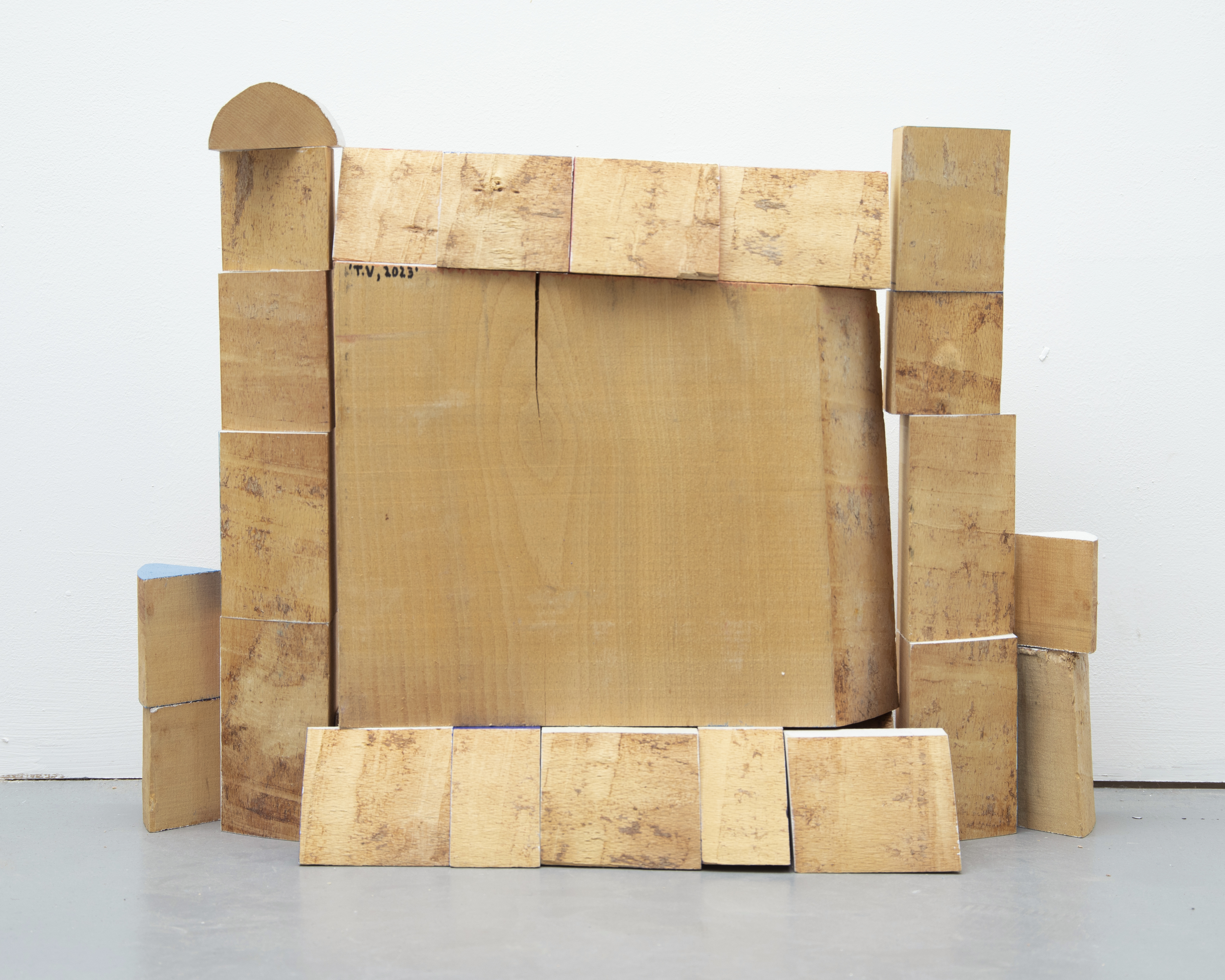
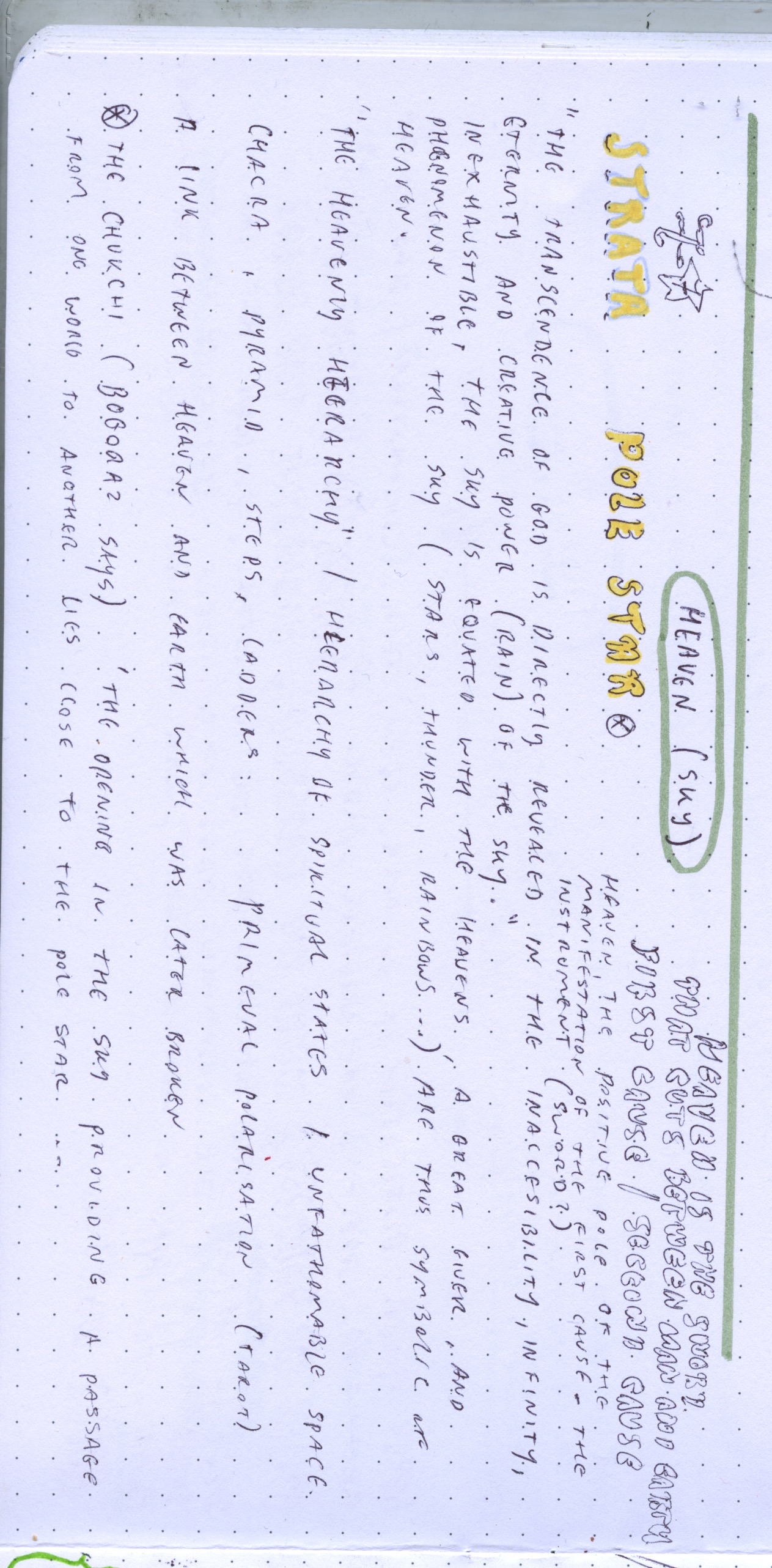
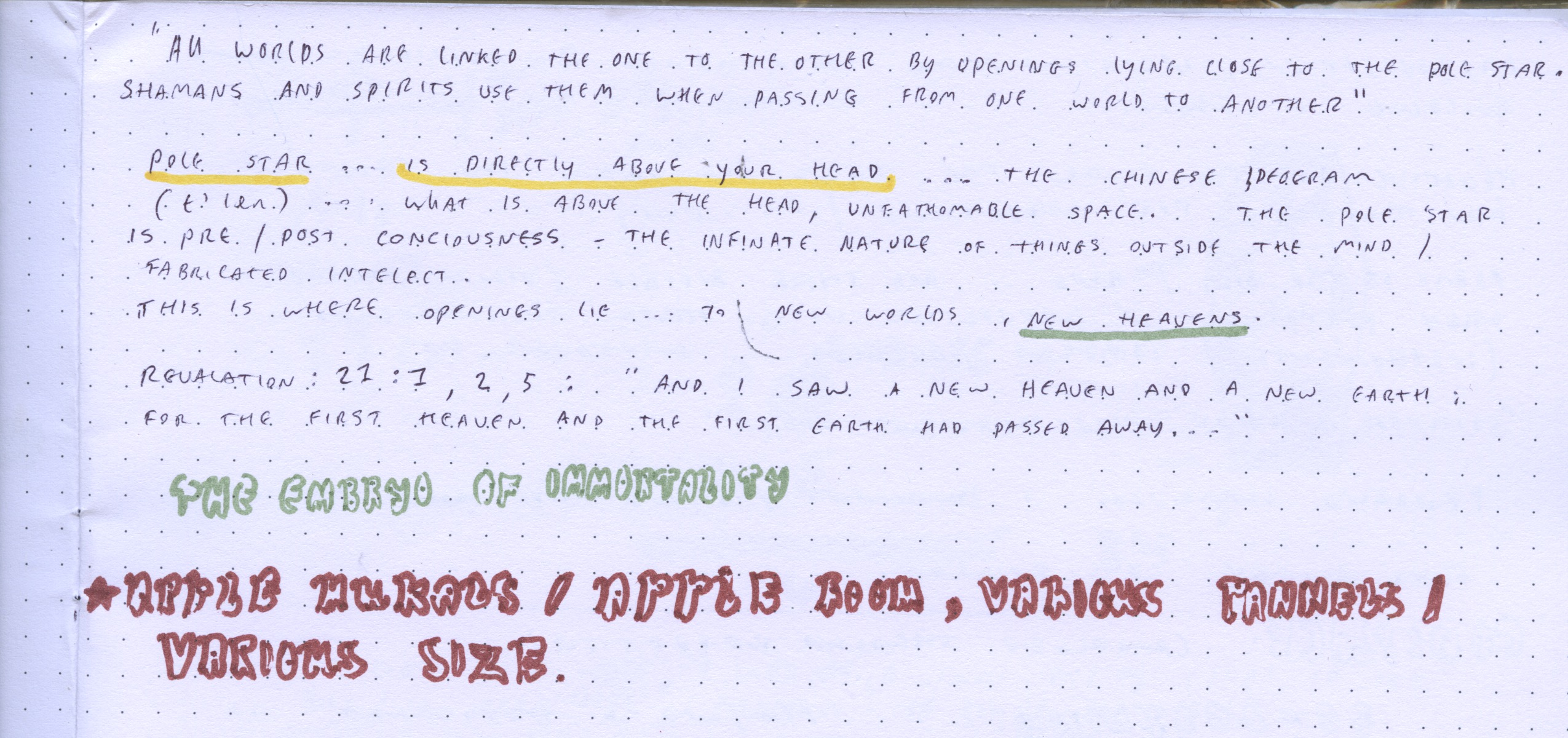
14/12/23 - Pole Star:
Using the Penguin Dictionary of symbols to trail off on tangents... in a ‘refining’ kind of way, making more notes on repeating symbols in my work.
I have found that in many theosophies, the Pole Star marks many gateways into extraterrestrial worlds and alternate planes. It is a guide, for the traveller - pointing to the space above the head, just outside of the reach of the egocentric consciousness. The pole star is a gateway/ portal. It attaches itself to themes of departure for the sake of return, in other words, ascension and de-cension, death and rebirth, and the spiral structure.
The star is both where we have been and where we are going.
To put the Pole Star inside a TV is to suggest something camouflaged, it is a consideration of what guides us - as to suggest a certain technology replacing, or acting as a sort of descendent of the guiding Pole Star (which in turn represents the heavens). what we look to for guidance has changed so much. To enter the sensibility of Phillip K. Dick’s Ubik, I tend to regard this TV, this technology, existing as the energy of the Pole Star, somehow warped by time.
A distant ancestor, barely recognisable - formed many generations along the spiral this guiding energy has travelled.
This energy, is the ‘thing’ that we look to for direction. There must always be something that we look to, and in the world, we inhabit, this dimension if you will, it seems to be what is on the screen. the screen is the new star, the ‘new heaven’.
In a comedic, sort of nostalgic way, the ‘TV’ is not fully relevant as a technology that captures the attention in 2023, but it serves as a symbol nonetheless, of that which draws the eye of the people of our age. the TV simply represents a digital technology, that which shines brightly, that is watched, and revered.
‘Digital’ as a concept is something I have recently come across following a seminar on Mass imaging with Duncan and Josef. Analogue as continuous, and Digital as broken. I imagine the digits of the hand, semi-independent limbs attached to a containing/ mothering form.
Within this context, the painted blocks that build this TV, and the building of a whole from smaller parts which the construction emphasises, serves to present a digital meditation. This is an accumulative process (like the Tarot), a building, weaving, multiplying, breaking - through which I can see that my creative process is an imitation of those impositions that I live within.
To regard analogue as continuous and digital as broken reads as a warning.
Edit 12/05/23:
Continuous and broken/ thus Analogue/ Digital, also relates to the difference between Henri Bergson‘s theory of ‘duration’; a “continuous, ever flowing sense of lived time” (1) and Gaston Bachelard’s theory of time as “Multiple and discontinuous [to be] considered as a series of micro-events” (2)
Bachelard would inerrably be an advocate of what the digital age could have been/ could maybe still be, in the fact that the multiplicity of information and sharing fostered over the internet for example, has the potential to overcome certain obstacles of study and purification.
Such a method of information sharing, if we were to describe the concept of the internet as a collection of independent but highly connected servers and users, could be seen to have the potential of tackling Bachelard’s described “Epistemological obstacles, or unconscious patterns or structures of knowledge” (3).
Bachelard describes these as relating to Bergson’s notion of ‘Duration’ and as “widespread within the sciences, and often [hindering] the development of new forms of scientific knowledge by denying the possibility of conceiving of new types of questions, let alone providing new answers” (4)
The ‘Digital’ theoretically perpetuates an experience of time and space that mirrors Bachelard’s concept of time as “Multiple and discontinuous [...] micro-events” (5). However, only If we were to eliminate the algorithmic takeover and monopoly/ weaponisation/politicisation of the version of the internet we currently encounter.
(1) Millar, J. (2007) Fischli and Weiss - The Way Things Go. London: Afterall. (p.34)
(2) ibid.
(3) ibid.
(4) ibid.
(5) ibid.
Joe Tilson, Monitor, 1964 BBCTV from Joe Tilson on Vimeo.
Joe Tilson, Private Landscapes, 1975 BBCTV from Joe Tilson on Vimeo.
Joe Tilson TV documentaries 1960s-70s:
Tillson’s work as a whole makes such a strong impression on me because I see it at the intersection of folk art and fine art.
As an artist he manages to balance himself between these two worlds; seemingly with the heart of a carpenter and the mind of a poet.
In ‘Private Landscapes’ Tilson speaks on his encounter with the division of the four elements, and how this information feeds into his creative process. I find it particularly inspiring in how it emulates my own experience with the division Marseille Tarot, and how an artist can use such structures as a framework for making further divisions, as well as understanding multiple existing ones.Tilson reminds us that one’s practice can be thought of as a “structuring process”... and synthesis of information - stitching together varied elements of research:
(Transcription from 'Private Landscapes' 1975):
“I Divided a notebook into four and wrote in each of those four sections the four elements that obviously fire brought to mind. I’ve not thought much about this before but It suddenly came to mind, the idea of Fire air water and earth so not knowing much about this I had no idea of how these things related, but gradually by reading more things I realized that things that I read before and a lot of things I was involved in reading again continually referred to these four elements, and they were obviously nothing to do with the elements known to science, but still remain very important because they are the elements that relate to human experience... and not only that but form part of a structuring process similar to my own in art which is made by people and has been made by people all over the earth in relationship to the sky the air earlier cosmogonies the beginning of the world things like that.
How - in other words - to understand where we are and our relationship with the world. So after this division, I began to realize that in fact it formed a circle and that fire, air, water, and earth not only related to the cardinal points - East, South, West, and North - but also Spring, Summer, Autumn, Winter... the cycle of the Seasons, the zodiac, the four ages of man. You know there were limitless possibilities of this division and how they worked, but of course, all this isn't some sort of abstract theory that I’m setting up, especially since that it's a really a synthesis of lots of other points of view.
It really is a structuring process which then gives rise to the possibility of very meaningful images. So coming from this are the images of the ziggurat, the ladder, the egg, the Labyrinth.
in other words, the theory actually ends up by being turned into art.”
(Joe Tilson, Private Landscapes, 1975)
JAAM (Publisher of sorts):
I have started/ am co-founding a publisher of sorts... selling handmade bags as well as publishing books. These are available online (depop, Instagram, Serchia gallery website) as well as at events/ fairs, and we also have intentions of contacting selected independent stores once stock is built up to a sufficient level.
“JAAM seeks to provide a space in which new artist collaborations are made towards producing sellable artworks.”
This was prompted by the event of the multiples fair that Duncan organised, as well as the desire to collaborate with my partner and foster a branch of my practice which focuses on independently generating income outside of the help of galleries.
In my last job before coming to study at Camberwell I was working as a traditional upholstery apprentice, which gave me a lot of practice with industrial sewing machines. Setting up my domestic sewing machine, and re-visiting this process has since opened up space for much experimentation. I have been served a reminder not just of the possibility to sew/ combine/ draw with the sewing machine in my practice... but also of the pleasure of working with fabrics.
JAAM also published its 1st book titled ‘Substitute Electro Kilim’ (Ed 30), which is now available online and in-store at BOOKS Peckham. This is a collection of notes and drawings I made on spreads of a German WW2 pistol catalogue. It meditates on the idea of language as a weapon (reminiscent of S. Delaney’s ‘Babel-17’) and what new territories emerge through the deconstruction and alienation of TV and novel excerpts.
INSTA: https://www.instagram.com/ja.am.2000/?hl=en
DEPOP: https://www.depop.com/jaam2000/
SERCHIA GALLERY SHOP: https://serchiagallery.square.site/s/shop







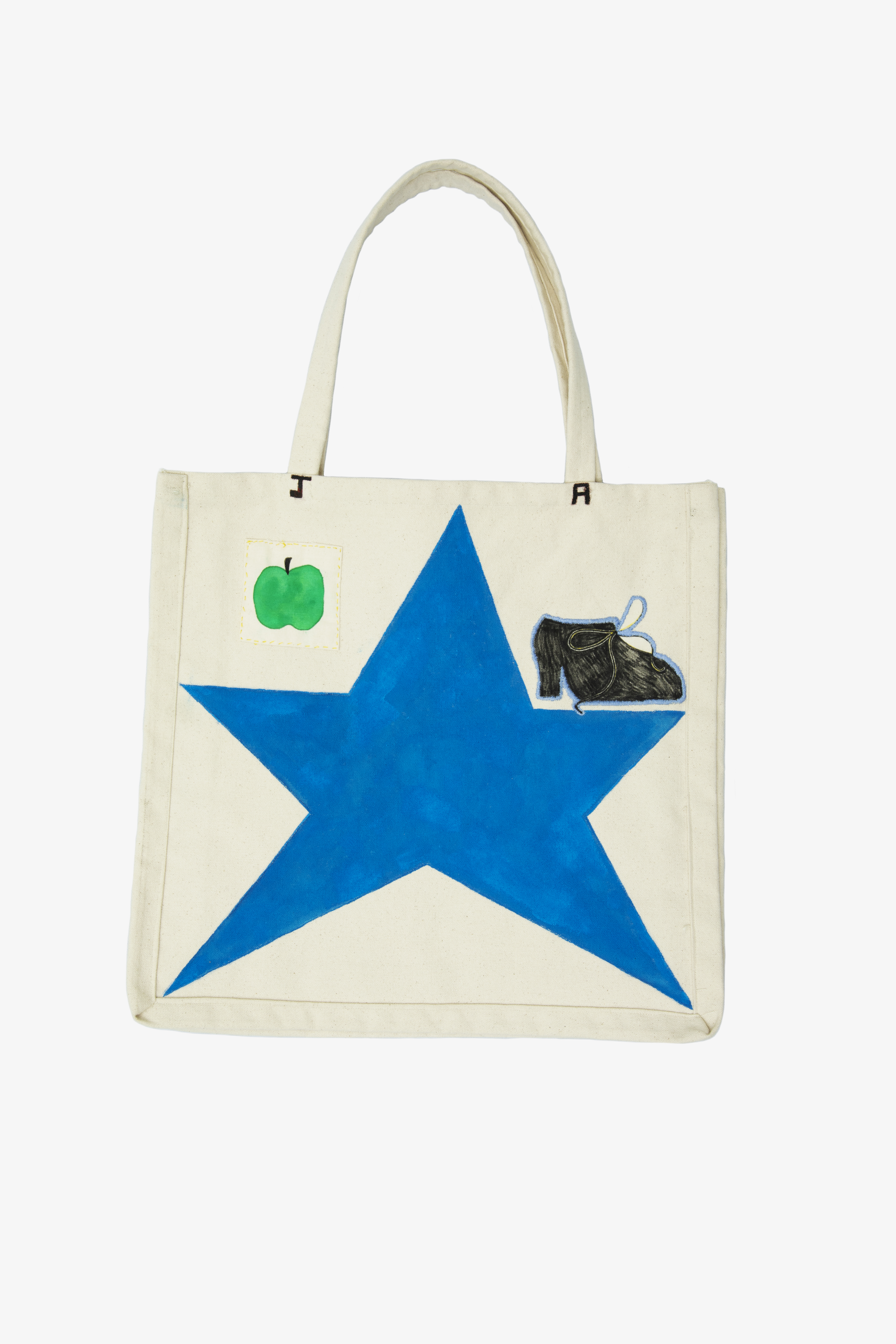

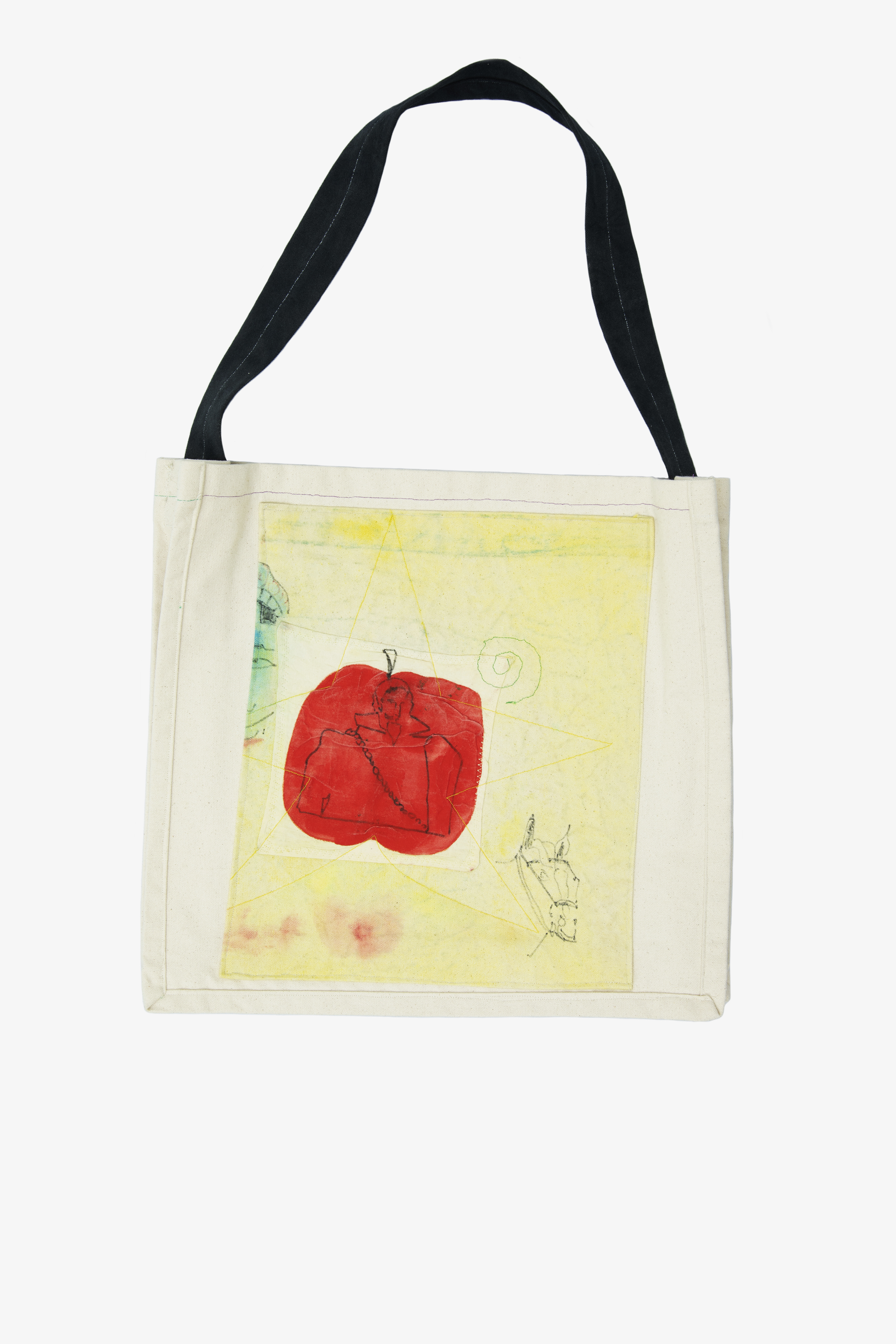


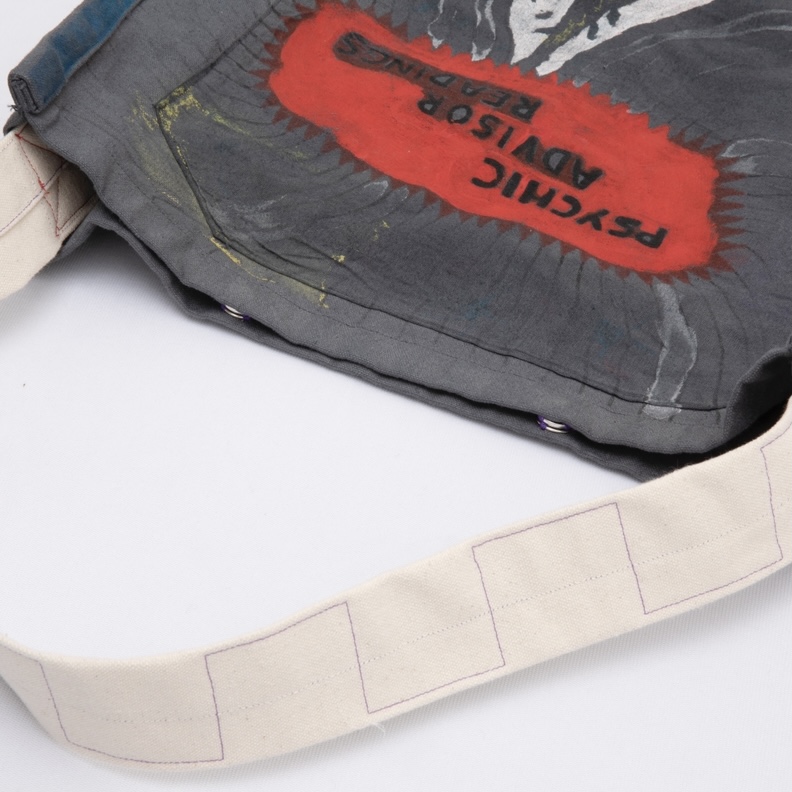

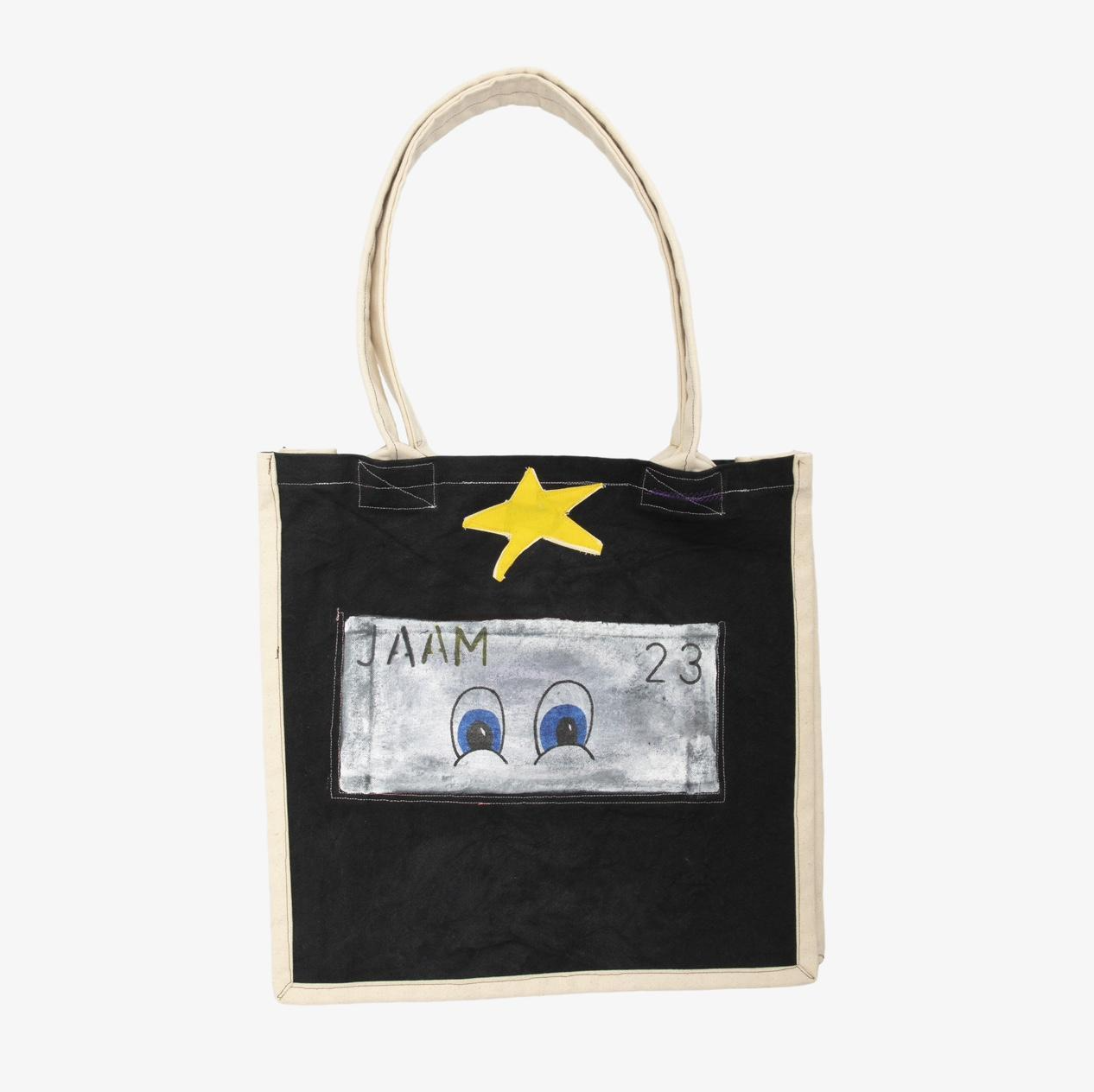


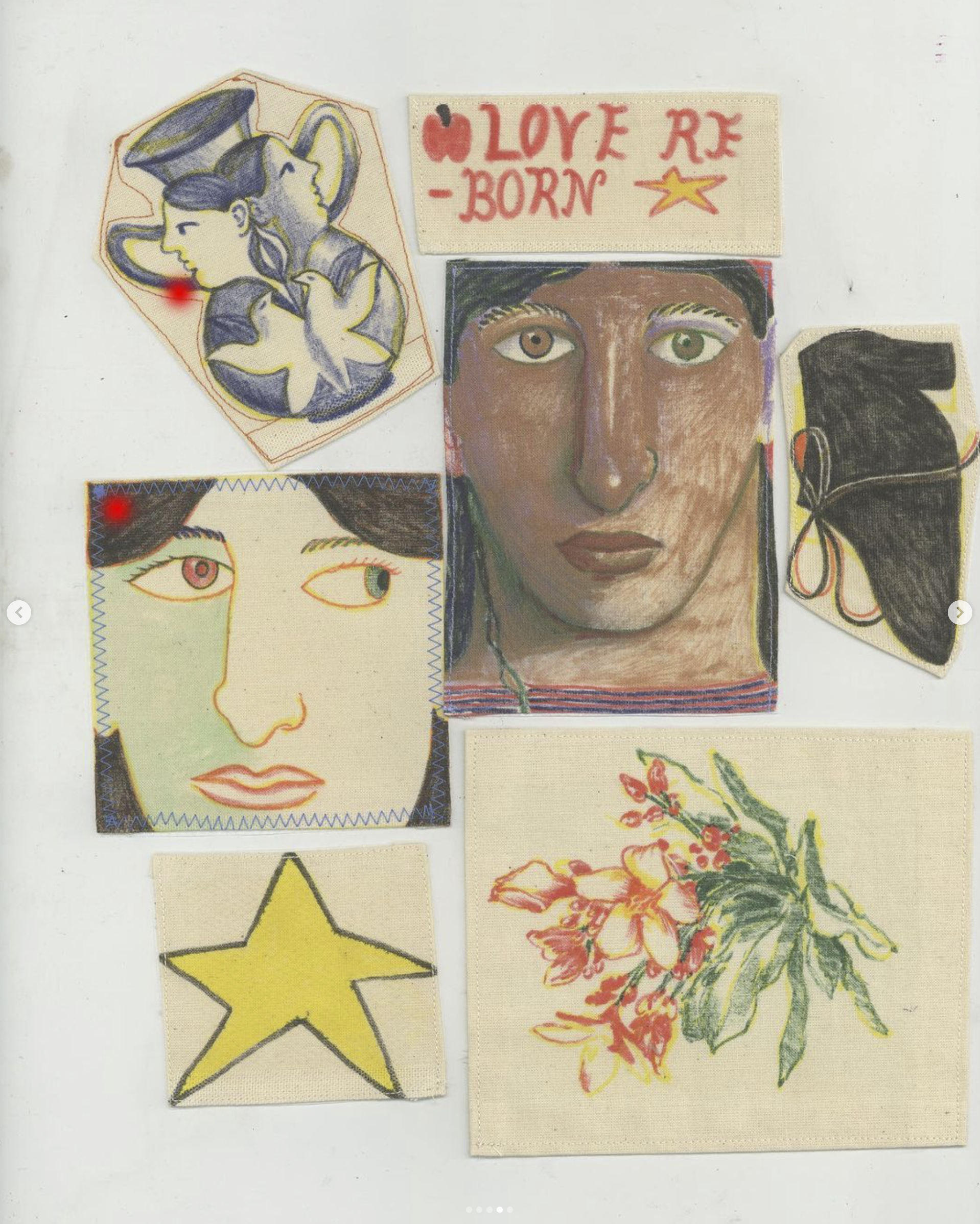
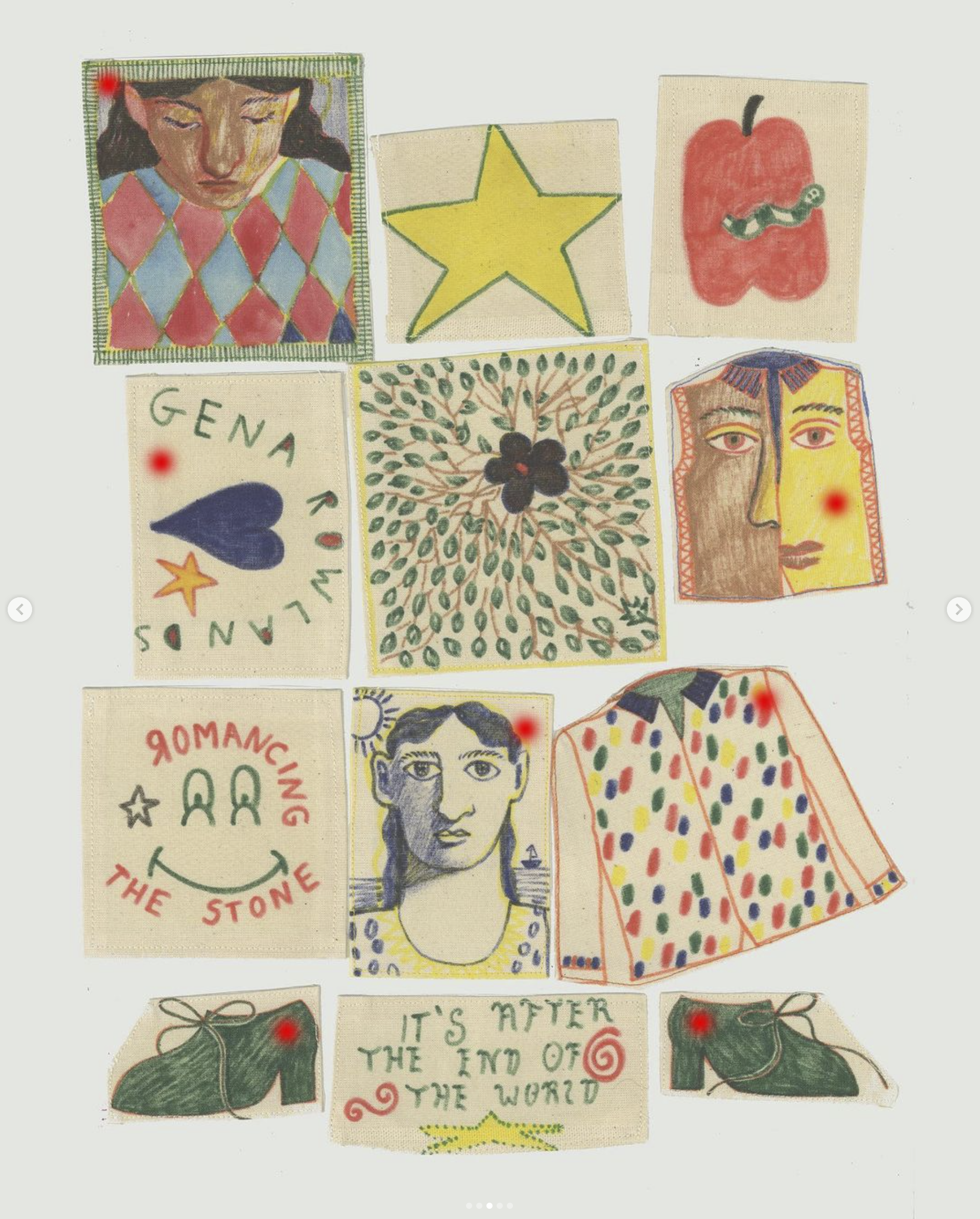


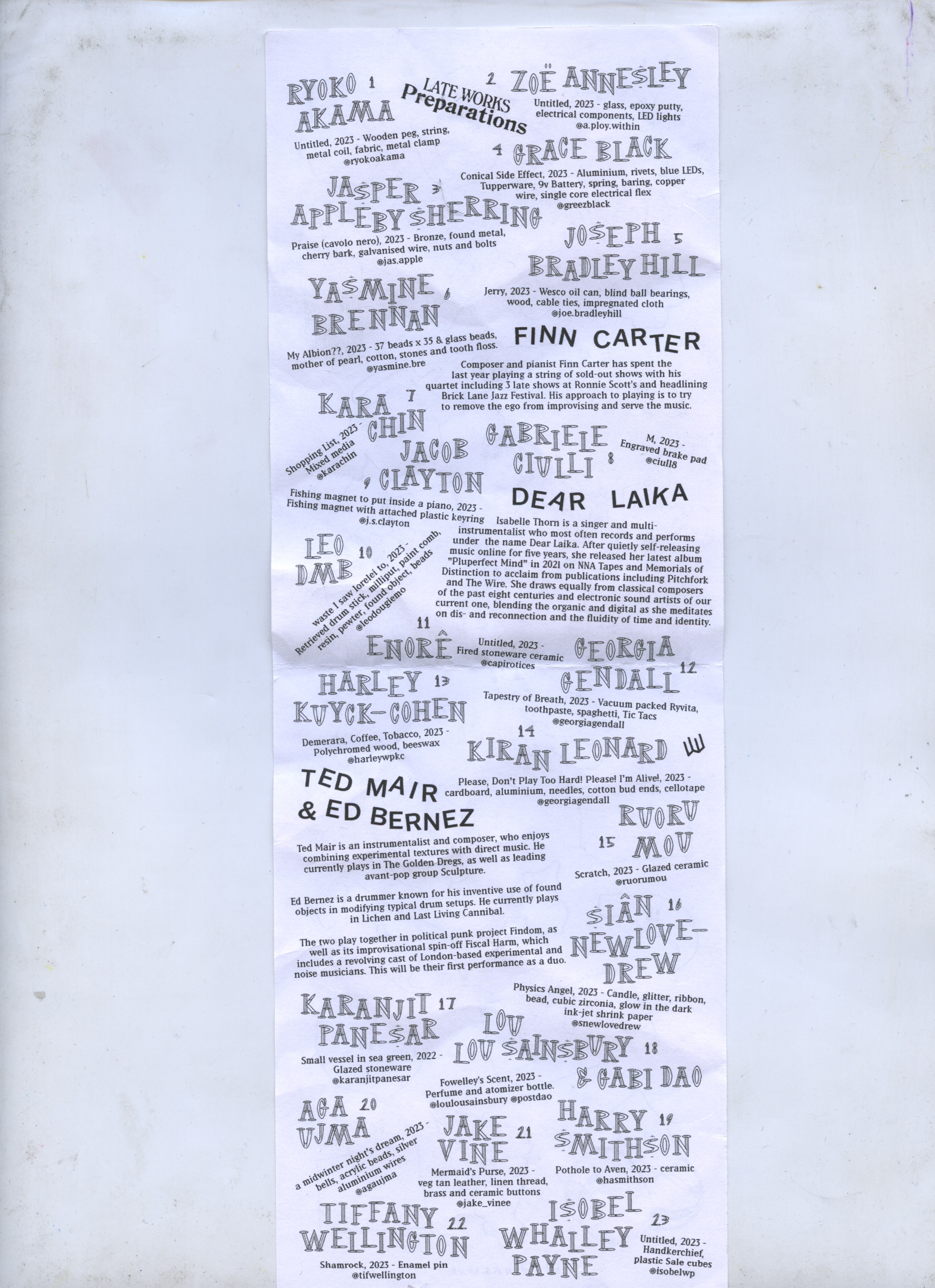
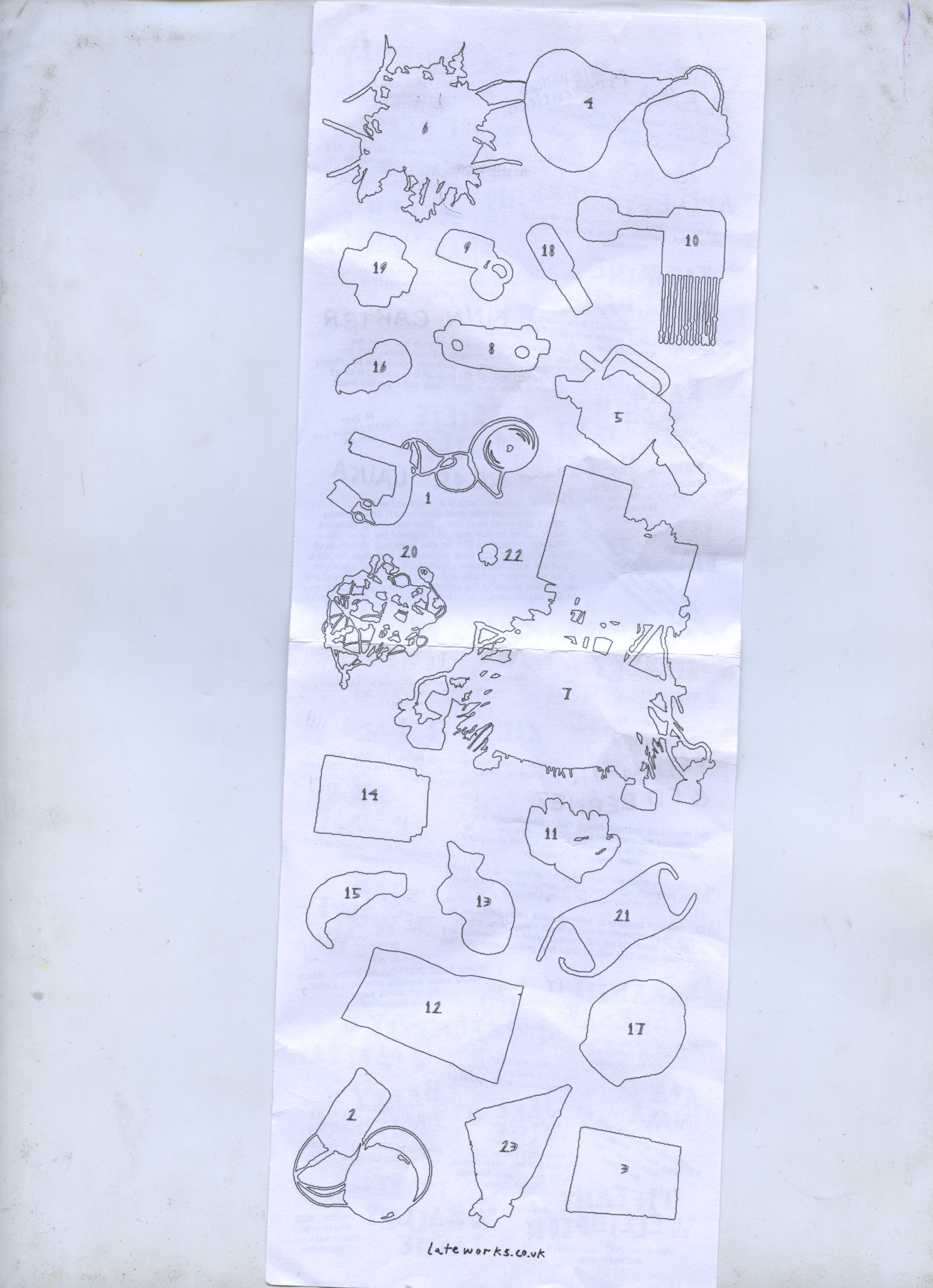

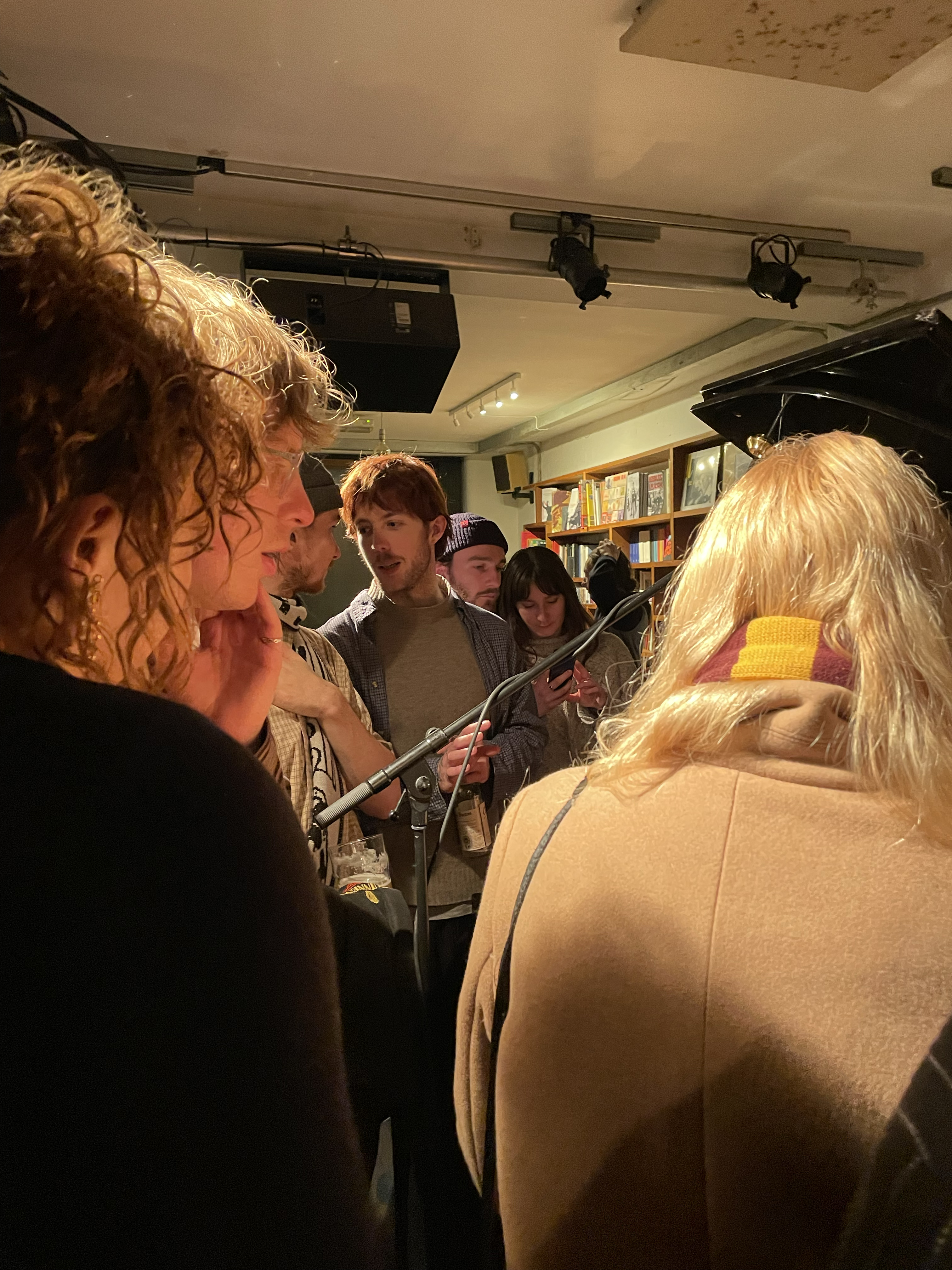


Lateworks: Preparations, Cafe Oto 13/12/23’:
Excerpt from Lateworks site:
“Concept:23 artists make a ‘preparation’ each for a grand piano. Three sets of musicians are then tasked with constructing individual live performances with the adaptable unit of preparations.
→ for a more detailed rundown of the concept click here
The second Late Works: Preparations took place once more at Cafe OTO on the same Yamaha C3 grand piano, carrying over the same limitations from the first iteration. More focus was put on using as wide a range of materials as possible in the creation of the preparations.
In contrast to the first, one of the groups was selected as a duo, with Ed Bernez focusing on percussive elements in the body, and Ted Mair focusing on the keys and pedals.
The musicians also only had one hour of practice with the preparations instead of the intended three hours. Another alteration made to the night is that all 23 sculptures remain inside the piano throughout, where they used to be on display before the first performance. Credits:
Musicians: Finn Carter, Dear Laika, Ted Mair & Ed Bernez
Artists: Ryoko Akama, Zoë Annesley, Jasper Appleby Sherring, Grace Black, Joseph Bradley Hill, Yasmine Brennan, Kara Chin, Gabriele Ciulli, Jacob Clayton, Leo DMB, enorê, Georgia Gendall, Harley Kuyck-Cohen, Kiran Leonard, Ruoru Mou, Siân Newlove-Drew, Karanjit Panesar, Lou Lou Sainsbury & Gabi Dao, Harry Smithson, Aga Ujma, Jake Vine, Tiffany Wellington & Isobel Whalley Payne
Concept, curation, design and filming: Joseph Bradley Hill • Sound Engineer: Kevin Shoemaker • Photographer: Luna Wang
Special thanks to Fielding, James & Midori!”
...
I have worked on a couple of things with Joe now, and if he asks me if I am up for something I know I will be!
What he does with Lateworks feels like a kind of extension of so many half ideas and thoughts I have had over the years. Essentially it is about art and music, the visual and the audible. Where do these cross over, how do they intersect and when and why and how?
I have tried to brainstorm ideas with Joe about future events and a lot of ideas are eliminated for being too contrived, or for not leaving enough room for the right kind of improvisation.
There is a delicate balance that Lateworks has uncovered, and it seems at this point that only the audible is qualified to respond to the visual in the context of a live event. Any ideas for attempts at reversing this relationship are dismissed in presupposing that a live visual response will fall short somehow.
I understand that there is a rich history of live improvisation in Jazz music, and this has always been something I have strived to mimic somehow... playing with the idea of the standard, with performance... but nothing quite equals up to a musician who knows their instrument to the degree that they can improvise in front of a live audience. And nothing can be transmitted so directly as music.
At this recent Lateworks event, I found myself contemplating this; the immediacy of music is in its independence of intellect and academia. Although this may be disputed in terms of music theory and what it takes to produce a score, the outcome is an expression that communicates entirely in itself - and this is always what I am striving for in visual art.
There is something about music as an uninhibited communication device. it seems to be able to bypass many filters... which is also perhaps why it becomes so alluring as a symbol for camouflaged information, for the trojan horse, and carriers of code.
Braincase portable console (63.5x43.5x3.5cm) Acrylic and soldered print-outs on lockable aluminium case, set into ply. 2019-23
Framing/ finishing... re-viewing past work, and bringing forward in time:
Taking an excerpt from a recent studio grant application; [there] “ is a process of finishing work which I am Incorporating into many of my pieces, where objects are set into found materials, using CNC routing, to create structures that both house pieces, while also becoming part of the structure of the work itself”
The artist’s frame has not just served as a process of finishing work and thinking about how works function in real, exhibiting space. It has also become a way through which I can
Particular works, such as the work above require to be left for longer until they come into play. I wonder if it is because they came to exist at the very start of thought, and could not yet be fully realised until joined with future ancestors/ companions within their intellectual/ physical lineage.
The idea of works waiting intrigues me and makes me consider the notion of Buddhist treasures buried for delayed transmission, or Hilma af Klint hiding her paintings for 20 years, due to her belief that the world she inhabited was not year ready to receive her ideas.
It also makes me think of a conversation I had with Duncan about the ‘lag’ between artist and viewer... which I immediately visualised as a kind of broadcast delay.
This is an interesting idea to meditate on, having considered works to act as time capsules. Does a work communicate more effectively if it strikes at the opportune moment?... or does it in fact develop through the very process of being misunderstood, re-interpreted, and misunderstood again?
To think of an artwork as the output of a mass of creative energy... a child...
children grow as they learn from their own mistakes, and perhaps our artworks need to be granted the same freedom for failure.
Edit 20/05/23: Further experiments in frame building, working more with my hands. Here I have tried out some simple tray frames with cheap ply and clear wax (more images in ‘selected works’). I left a ‘Camberwell superstores’ sticker on one of the batons as a time stamp, a clue buried for later years. Talking in an interview I did recently for a magazine this work came up, and it brought us onto the subject of cave paintings, Buddhist treasures, and the recent exhibition of Hilma af Klint.
There is an activity of laying down clues in the aforementioned practices and embedding information for later retrieval which I enjoy. In my work this need not necessarily be a deep statement or concept... but simply just giving space - at the right moments - for materials to make their own coincidental/ temporal (and thus dateable) expressions. For allowing chance to play its hand... for knowing that I will not be living in Camberwell my whole life, and thus such a mark, eventually, will become a marker of a specific space and time - contradicting in still unknown ways to the one I am in the future.
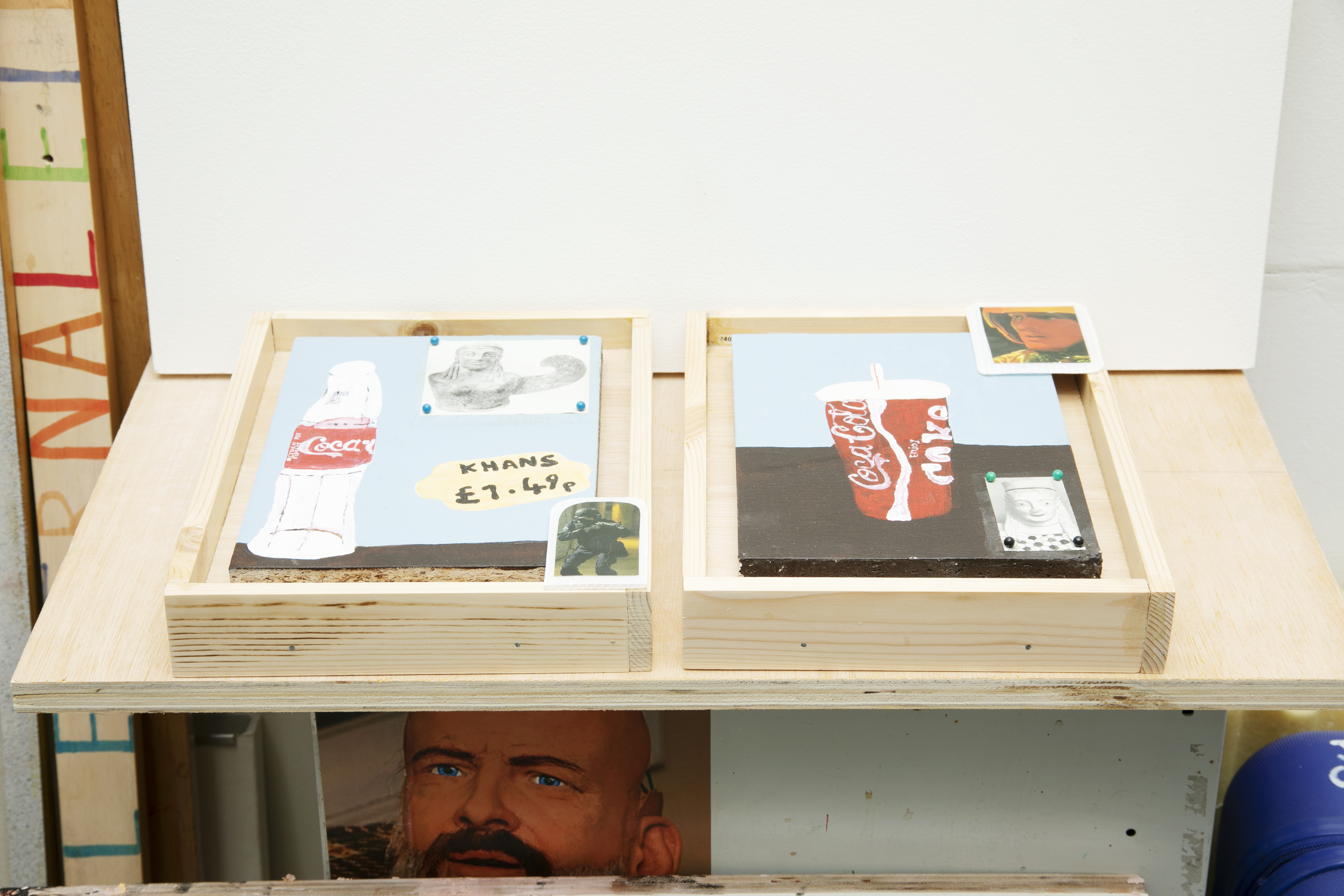
‘A coke telephone and a bottle of coke imported from Nigeria, one looks like it could have coke in it but that's the telephone, the other is empty because it was drank by me, the artist’ [Pt 1 & 2] (19.5 x 26cm) Acrylic & photo-cut outs on chipboard, in waxed ply artist's frame. 2023
Executive decisions (27:56 min) Digital video, 2023
‘Executive decisions’ format 23 submission (video and visualisation of process/ chain reaction - ref the way things go & Slacker):
For the Format 23 open call, my partner and I shot a short video meditating on the subject of letting go of an artwork.
In the film, we cycle around South London and I speak on my book E2-E4 which I published in 2017, and through which I received some praise through a book award and a few exhibitions.
Looking back on the book itself, I realised it represented a past life for me. Bureaucratic in its aesthetic and function as a catalogue of independent indexed works - it both represents aesthetic and conceptual decisions I have pulled away from, as well as contains fragments of photographic memory of a past relationship, and locations I have since experienced distance from both physically and mentally.
re-watching the edit of this film we made together I have become increasingly aware of how time becomes buried in work, inextricable from it. I look at this work now like a cave painting, something passed. It is something I was once so close to but that now remains only as an artefact of a past journey.
There is something extremely liberating about this, and as I learn the importance of letting go, joy and freedom permeate my work.
In its physicality, the film evolves as a series of spontaneous events - one could reference Bachelard in describing them as “Multiple and discontinuous [...] micro-events” (1) - in a chain made visible through the medium of film itself (following one thing into the next, into the next). Starting with picking up the camera and reading the brief of the open call, the method of shooting the footage took inspiration from two of my most treasured films; Richard Linklatter’s ‘Slacker’ (1992) and ‘ Fischli and Weiss’ ‘The way things go’ (1987).
In both of these films, there is an illusion of continuity on the surface level, as one event seems to naturally birth the other into existence (in TWTG this is through the physics of objects colliding/ in Slacker this is through conversation and social coincidence).
Both films are in this way representative of Henri Bergson‘s theory of ‘duration’, playing with the notion of ‘lived time’ as we progress from one event to the next. (see Online Platform entry ‘14/12/23 - Pole Star‘),
However, upon closer inspection, this illusion of continuity is discoverable as a facade. Whether it is in the rough cuts of TWTG, or the finely scripted production of Slacker, we realise what we are seeing is a controlled series of performances. What seems coincidence is staged, and what appears to be a domino effect is fought against in moments of energetic entropy, pushed along, extended.
Therefore, in the reality of their production, both films subscribe to something far closer to Gaston Bachelard’s theory of time as “Multiple and discontinuous” (2).
It is in this fact, this hovering between expectations and realities of experienced time, that I find something ultimately real about the position these two films take.
What is formed is a meditation similar to that of the battle between theories of inescapable human subjectivity and object-oriented ontology.
There is essentialy ‘Time’ as we piece it together in our heads, and ‘Time’ as it exists independently of us - and films such as TWTG and Slacker in the very nature of their contradictions illuminate this division.
1) Millar, J. (2007) Fischli and Weiss - The Way Things Go. London: Afterall. (p.34)
2) ibid.
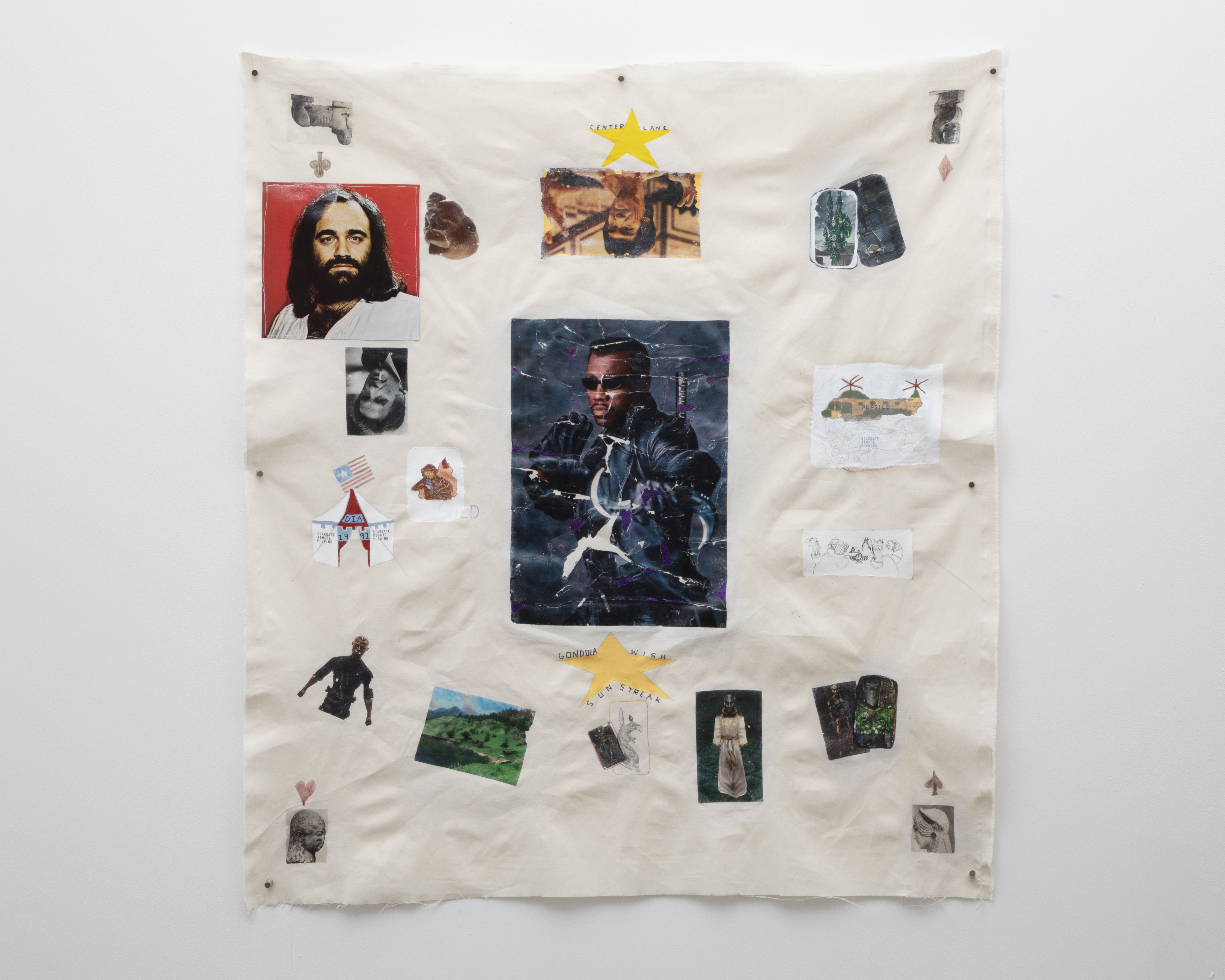

‘Arcanum XXI’ (95 x 106cm) Gel transfer & acrylic on calico, C134 Install. 2023. (BEFORE STRETCHING/ FRAMING)
‘Imperial City’s most wanted’ (50x55cm) Gel transfer & marker on stretched calico W/ strip-wood artist frame. 2023
Gel transfers, inter-dimensional poker. The Greek statue, the movie star, the avatar... same energy in entropy, through different dimensions:
Greek statues have been making appearances as spectators/ deities within recent works, as has the symbol of the Pole Star, and recently the video game avatar too.
Greek statues (mythologies, idolisms) gather in rectangular corners eluding to houses of the tarot, overseers of events - governing receptivity and activity towards the heavens and earth. They also mingle with stars and avatars... they all jostle for position in a metaphysical battle between the past and the future.
catalogued, as well as in a state of play (‘Arcanum XXI’ is organised as a game of poker), such figures are brought together with the intention of visualising a rift in the fabric of space and time.
There is a guiding light which has always been present, in the fact that we are always looking forwards, towards, in anticipation of guidance. This light itself is a marker of worlds, and as it has shifted into new forms I believe these to mark the birthing of new dimensions, generational...each new plane the offspring of its predecessor, and yet abandoning the generational hierarchy insofar as each plane opens an independent and infinite duration of time, on a quantum mechanic level in which separate worlds co-exist alongside each other. “Multiple and discontinuous” (1)
1) Millar, J. (2007) Fischli and Weiss - The Way Things Go. London: Afterall. (p. 34)